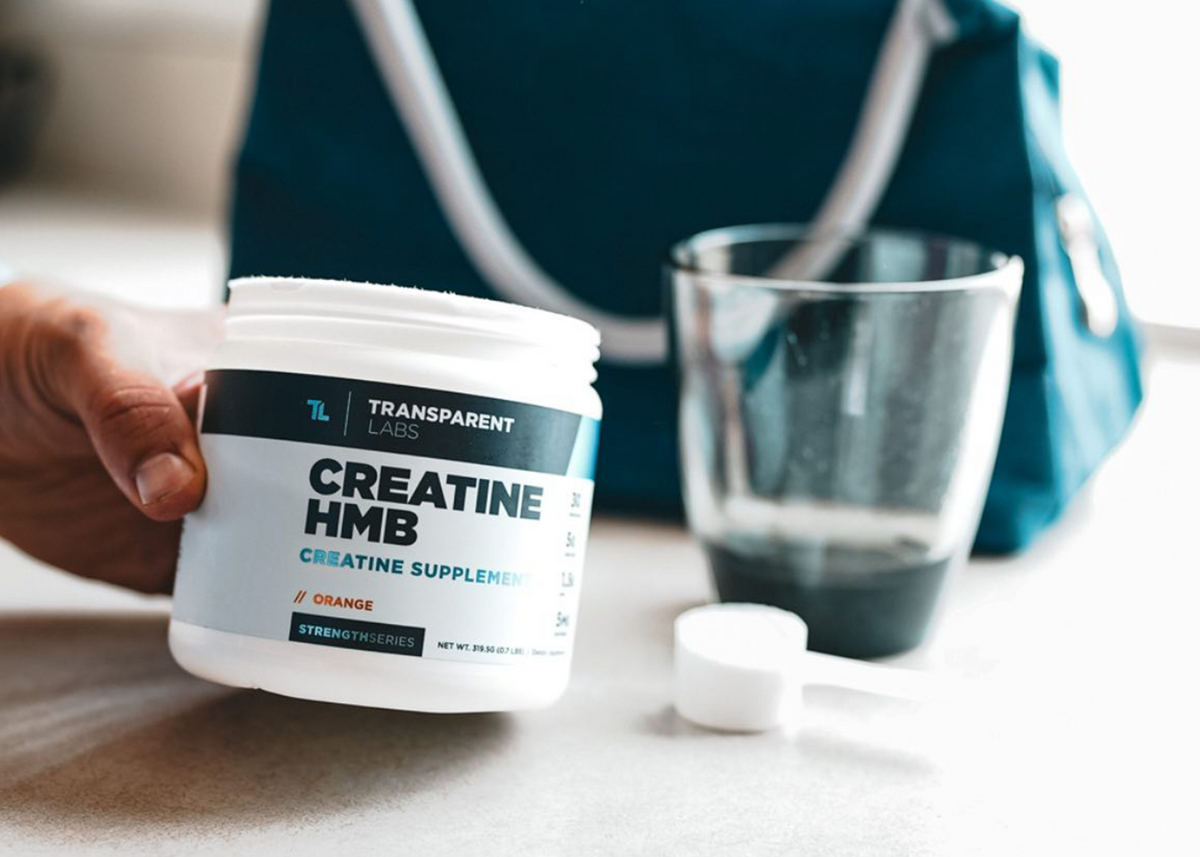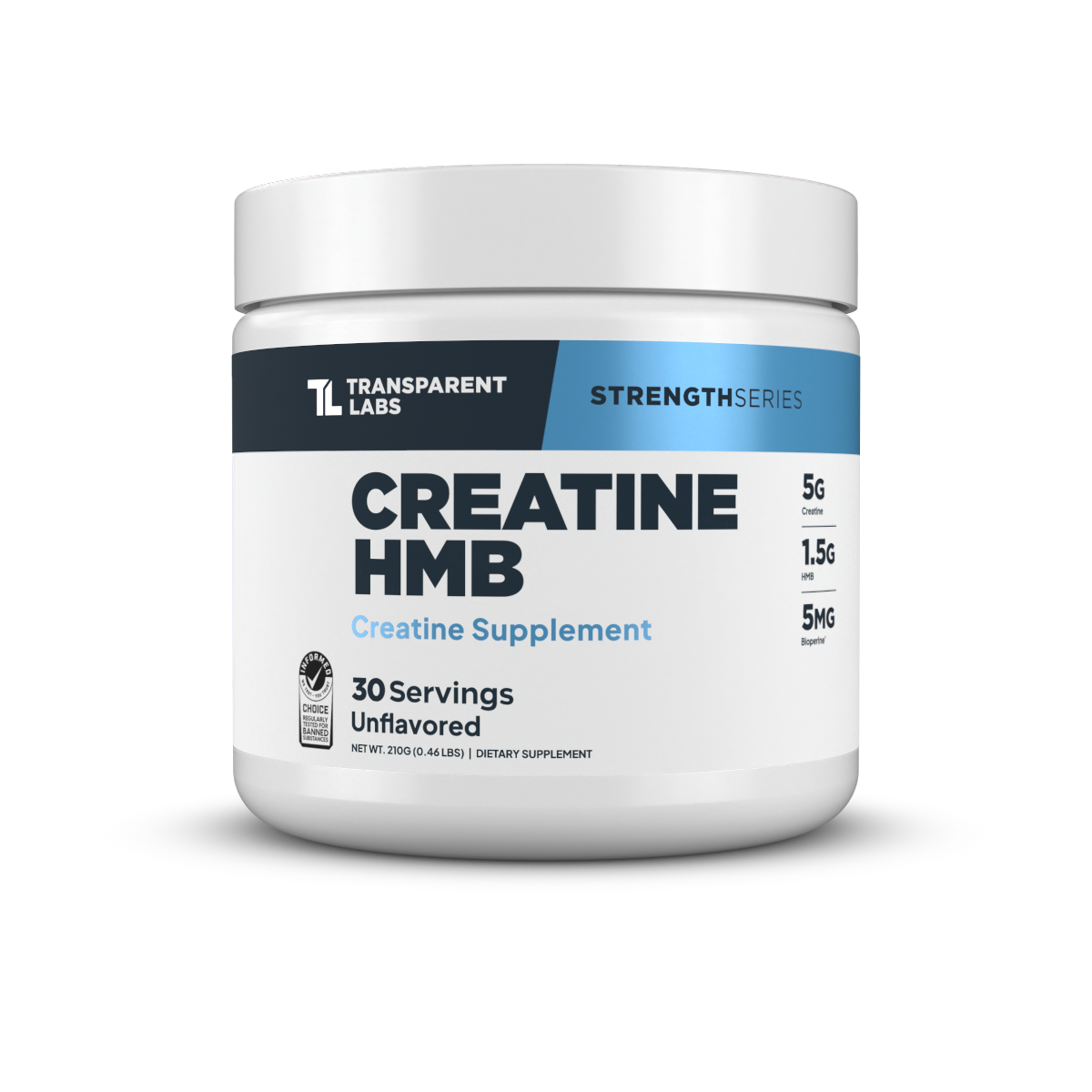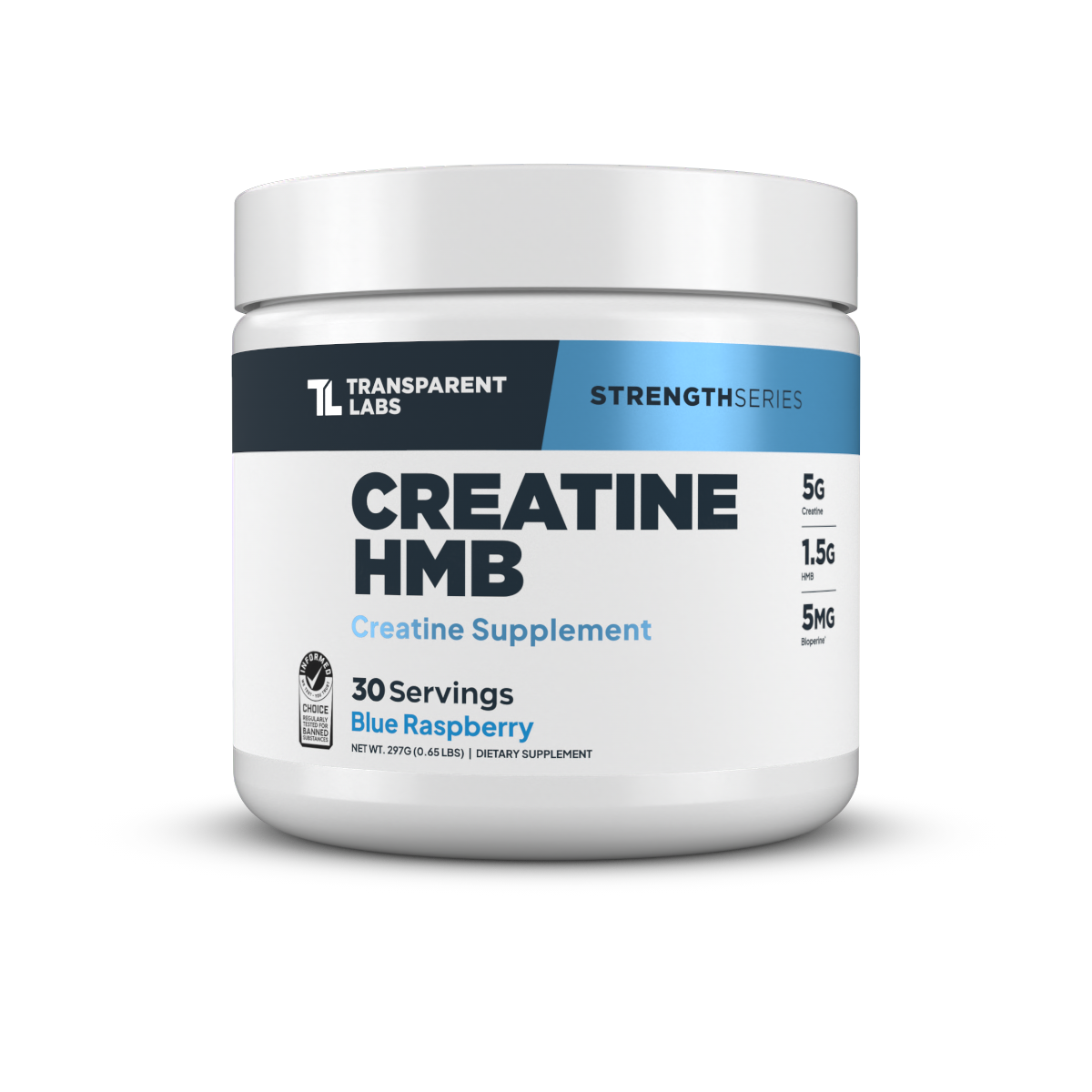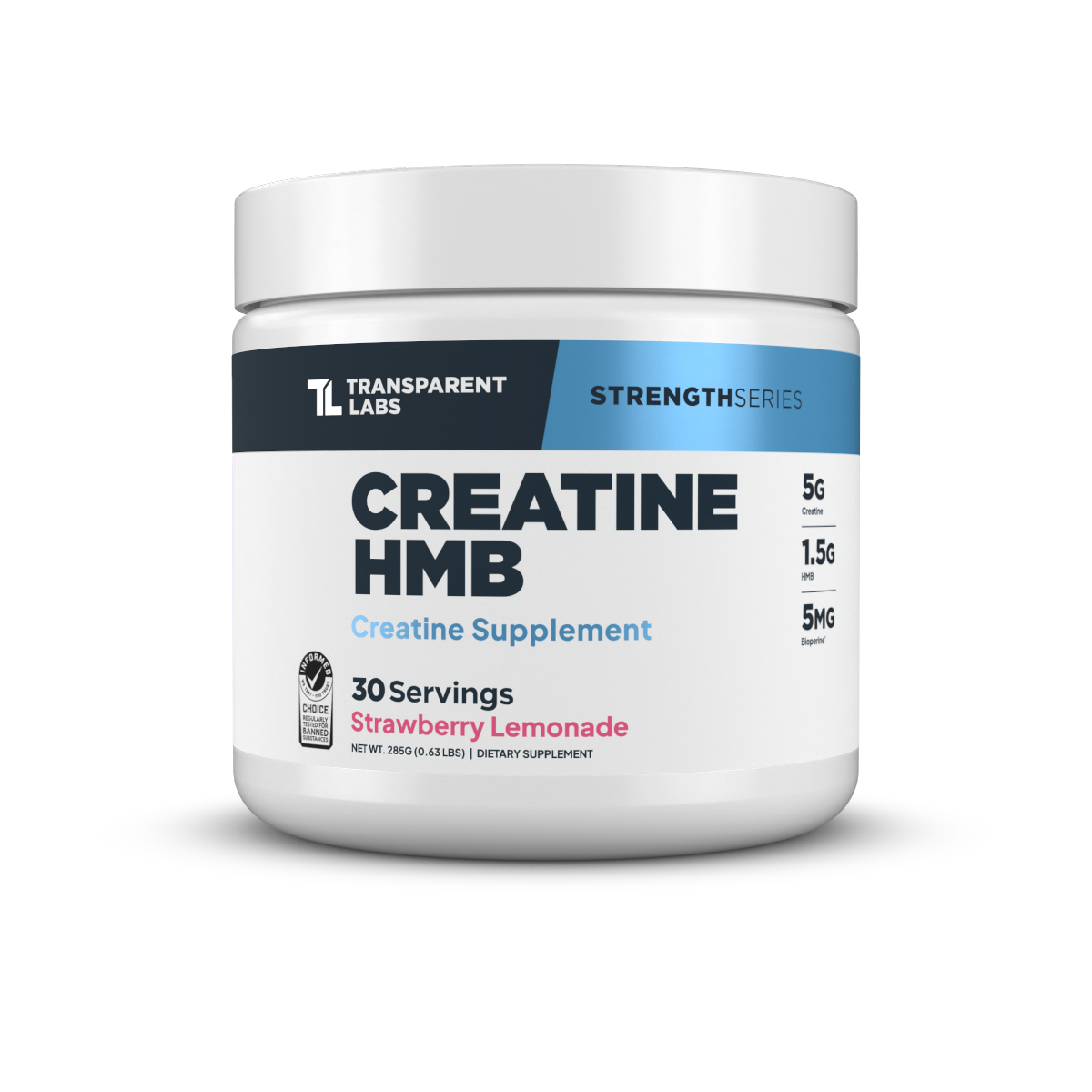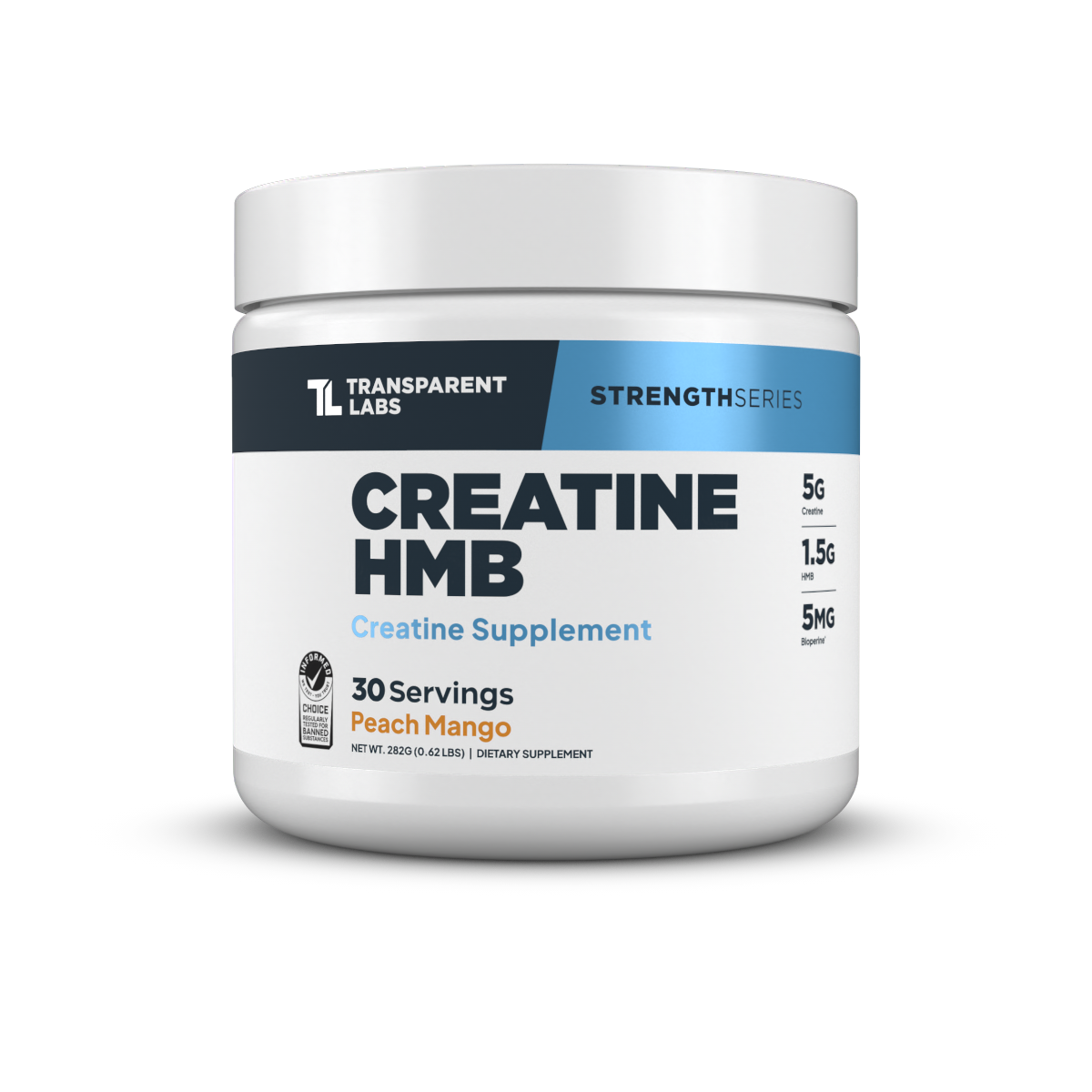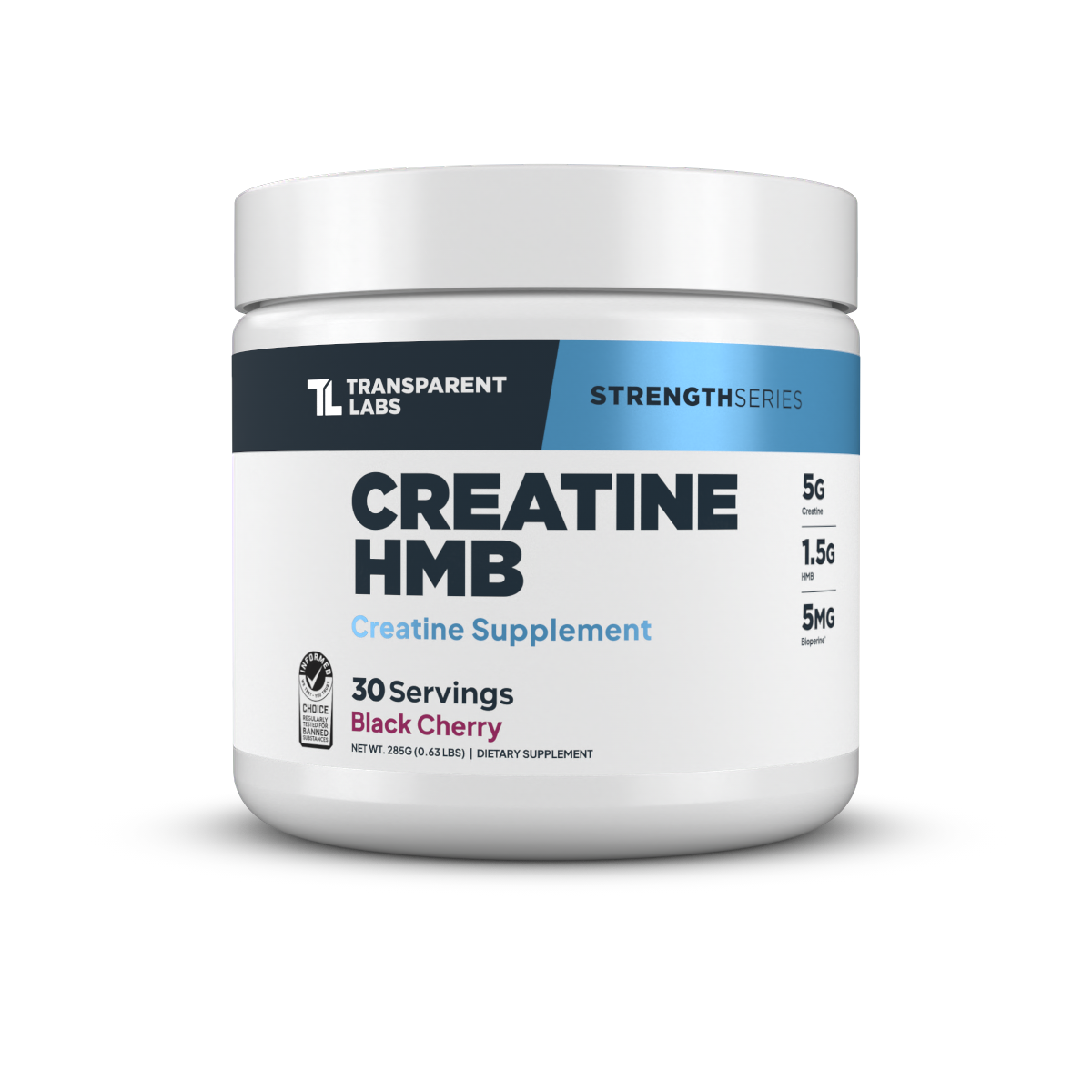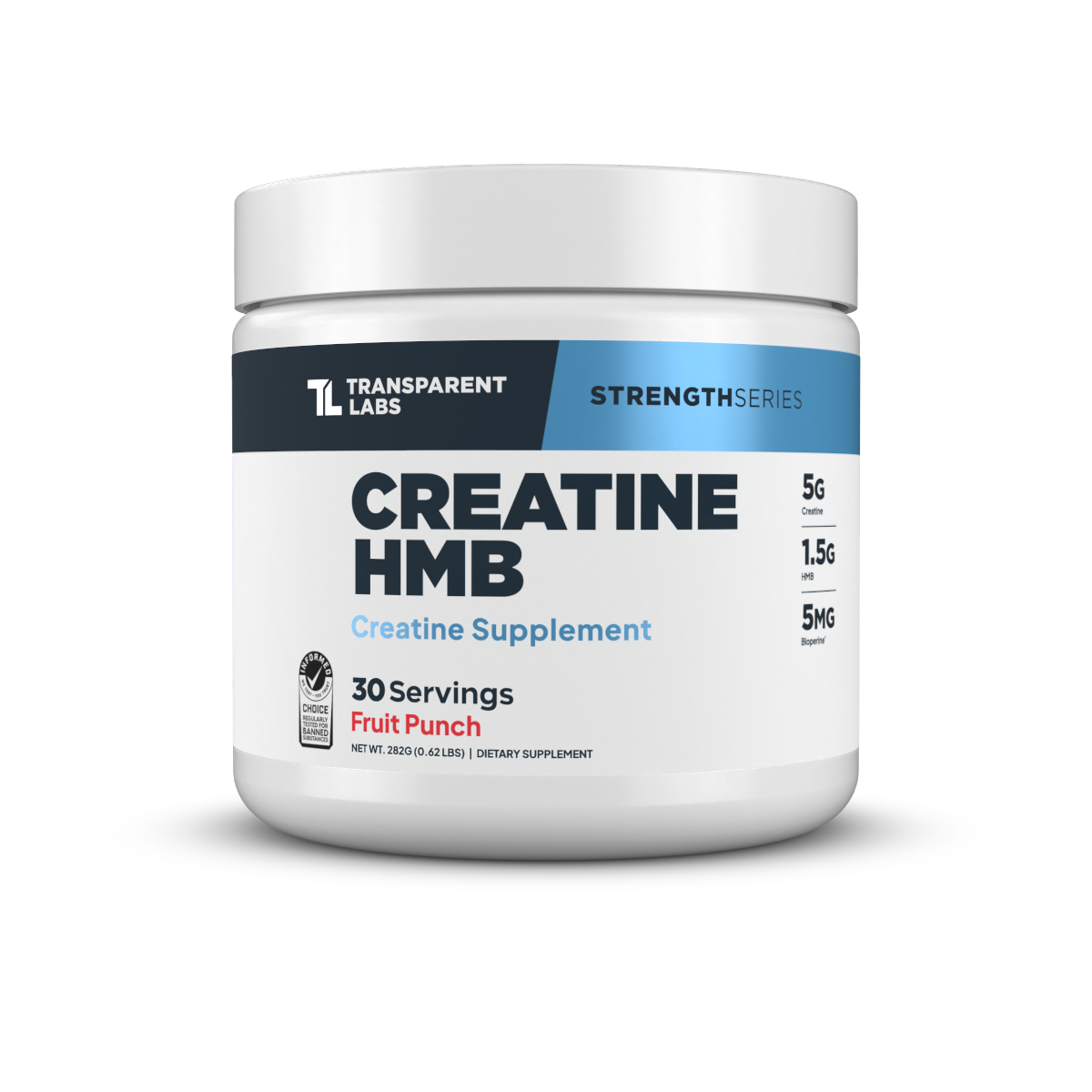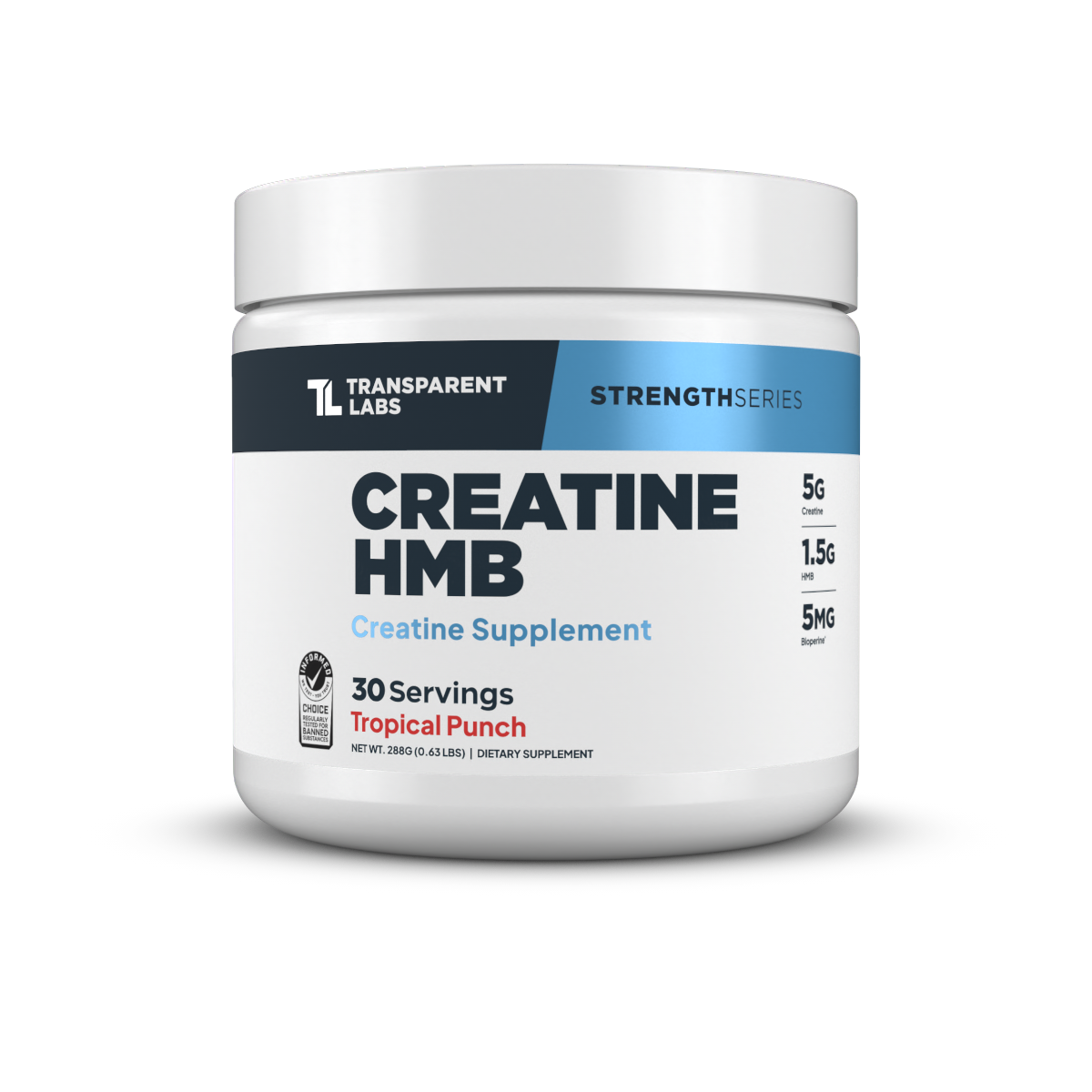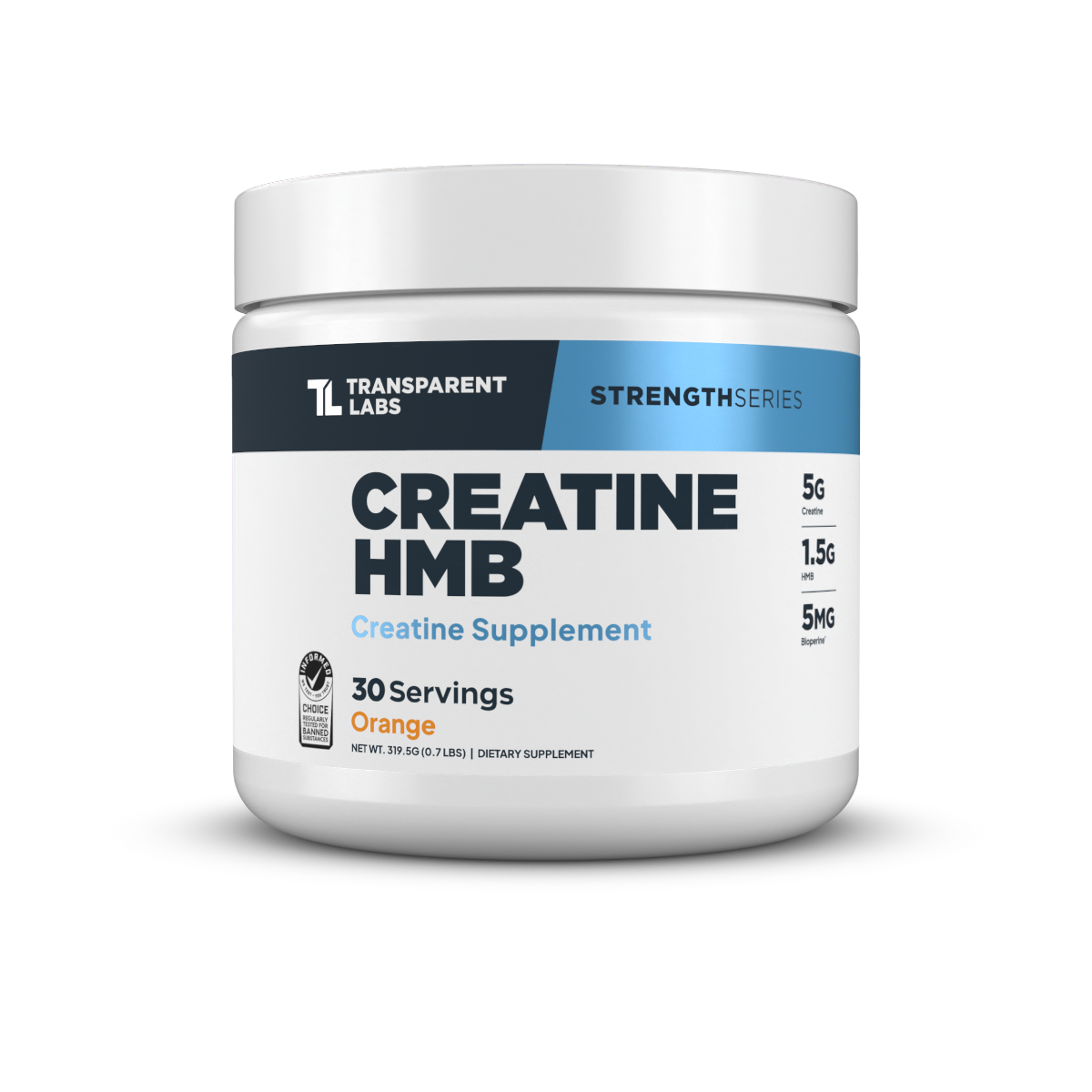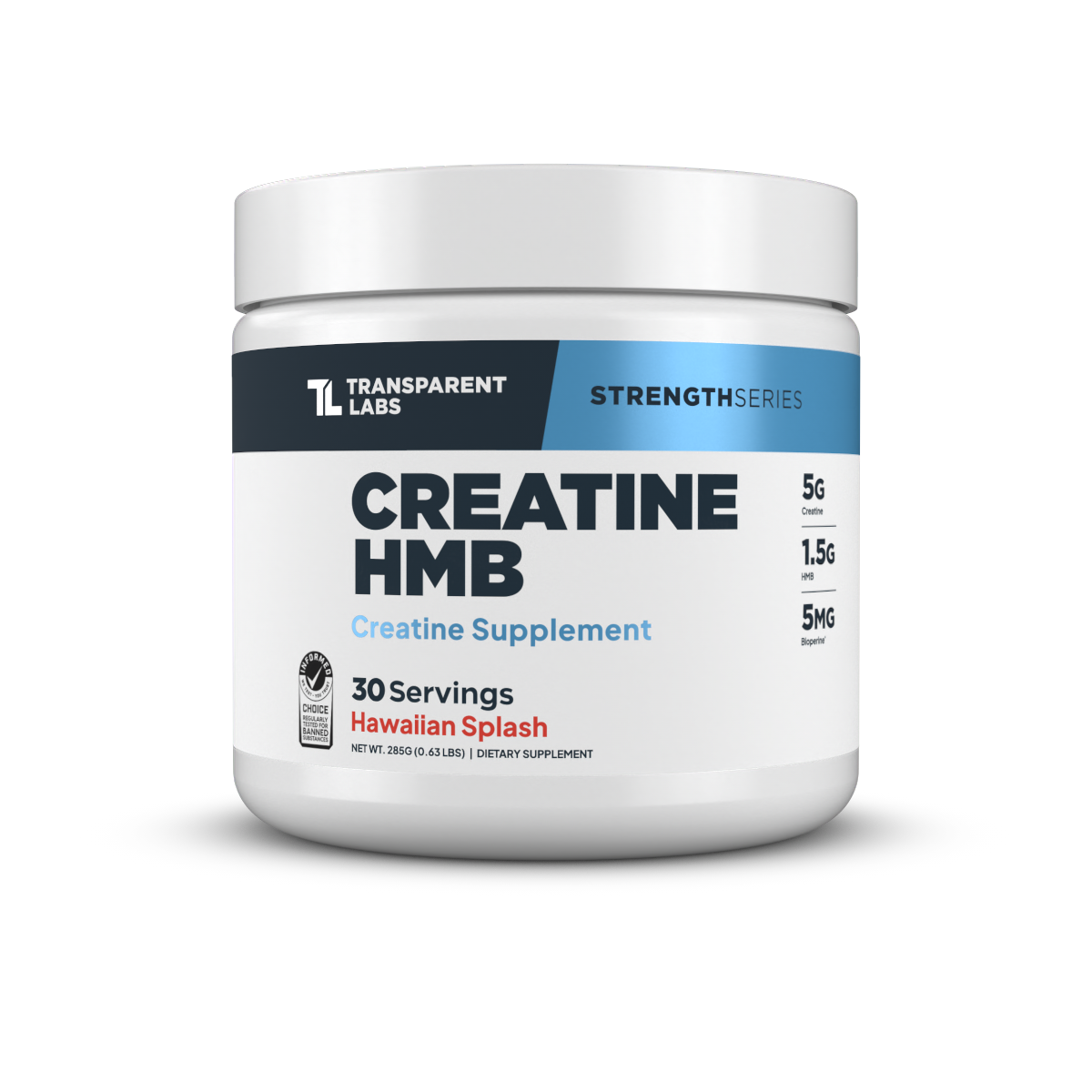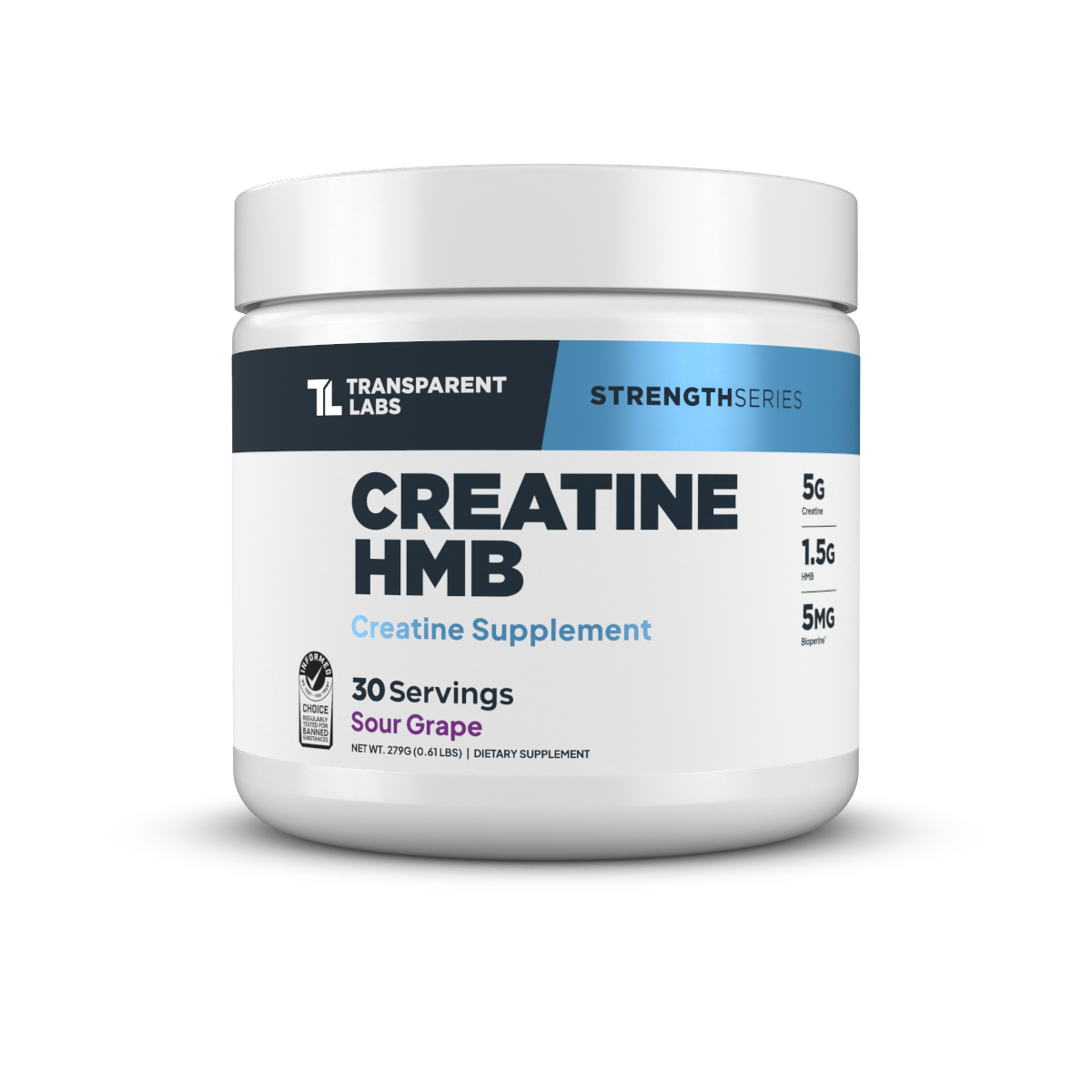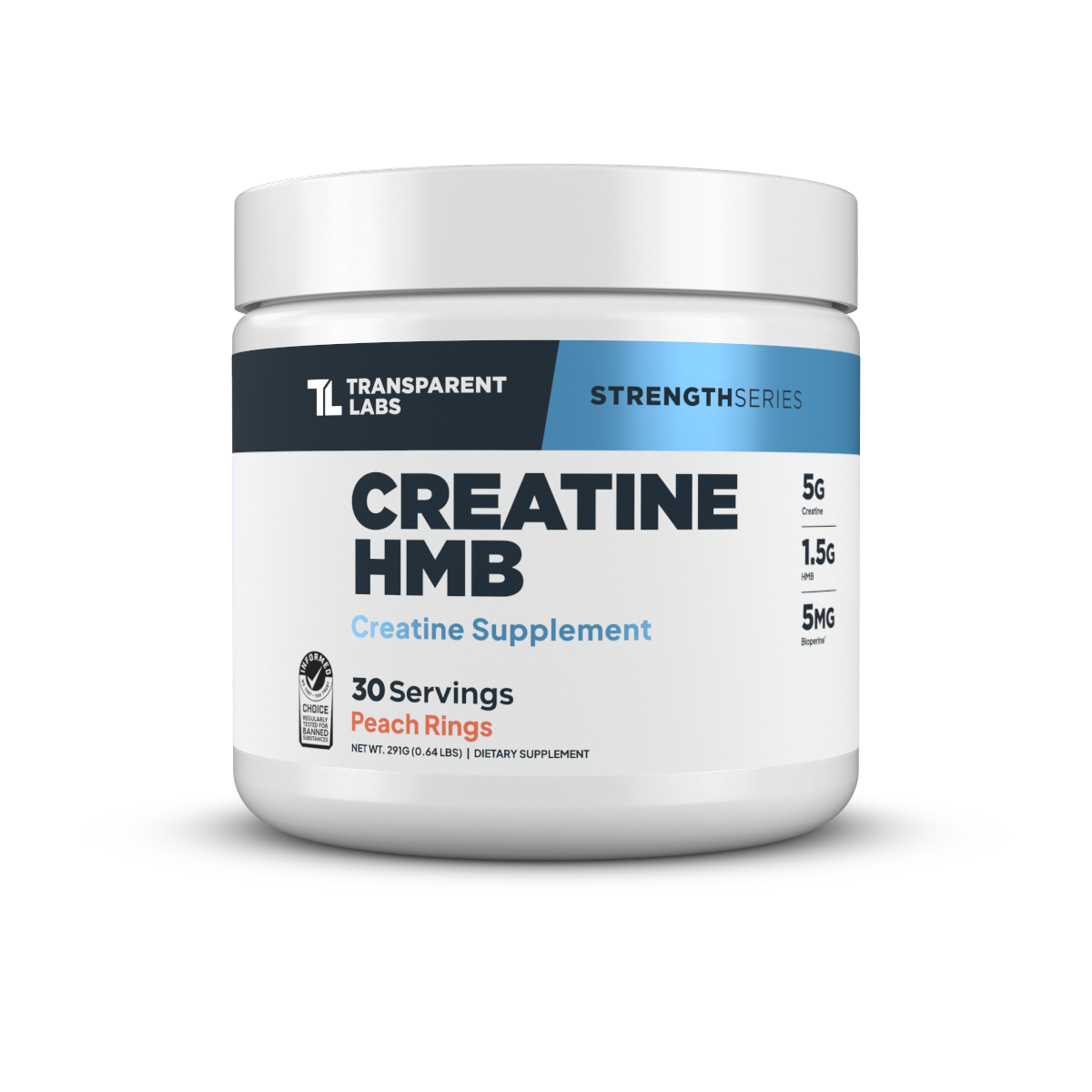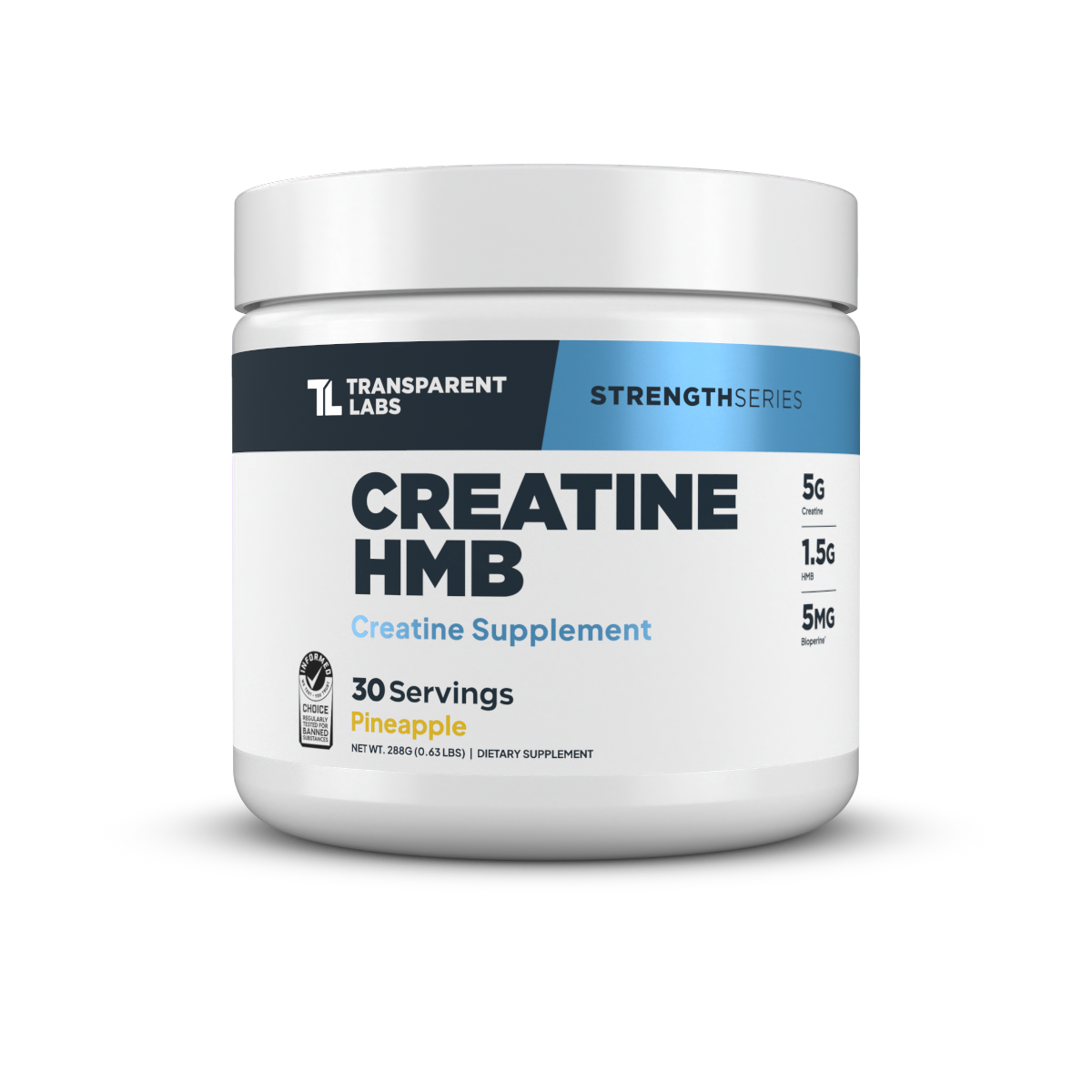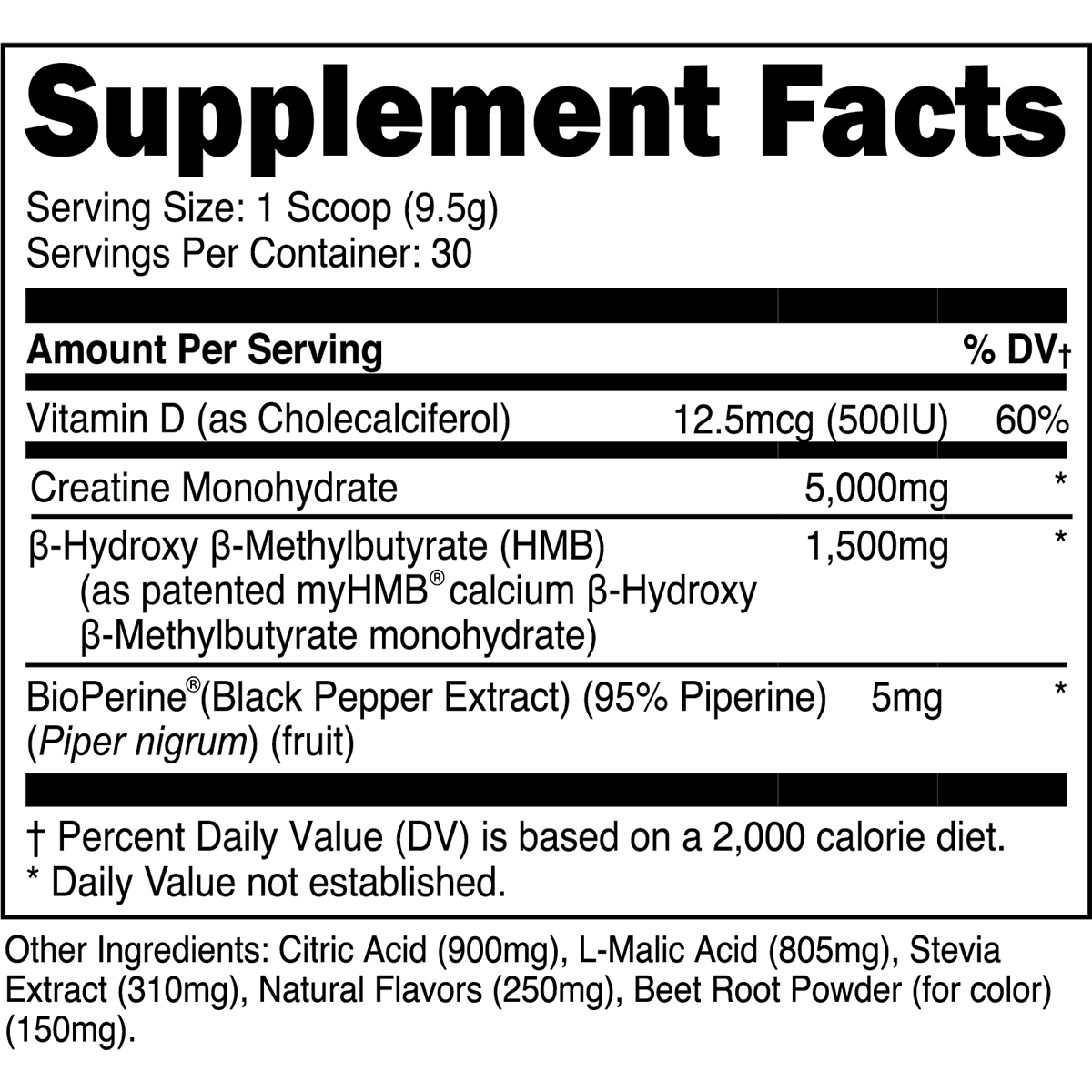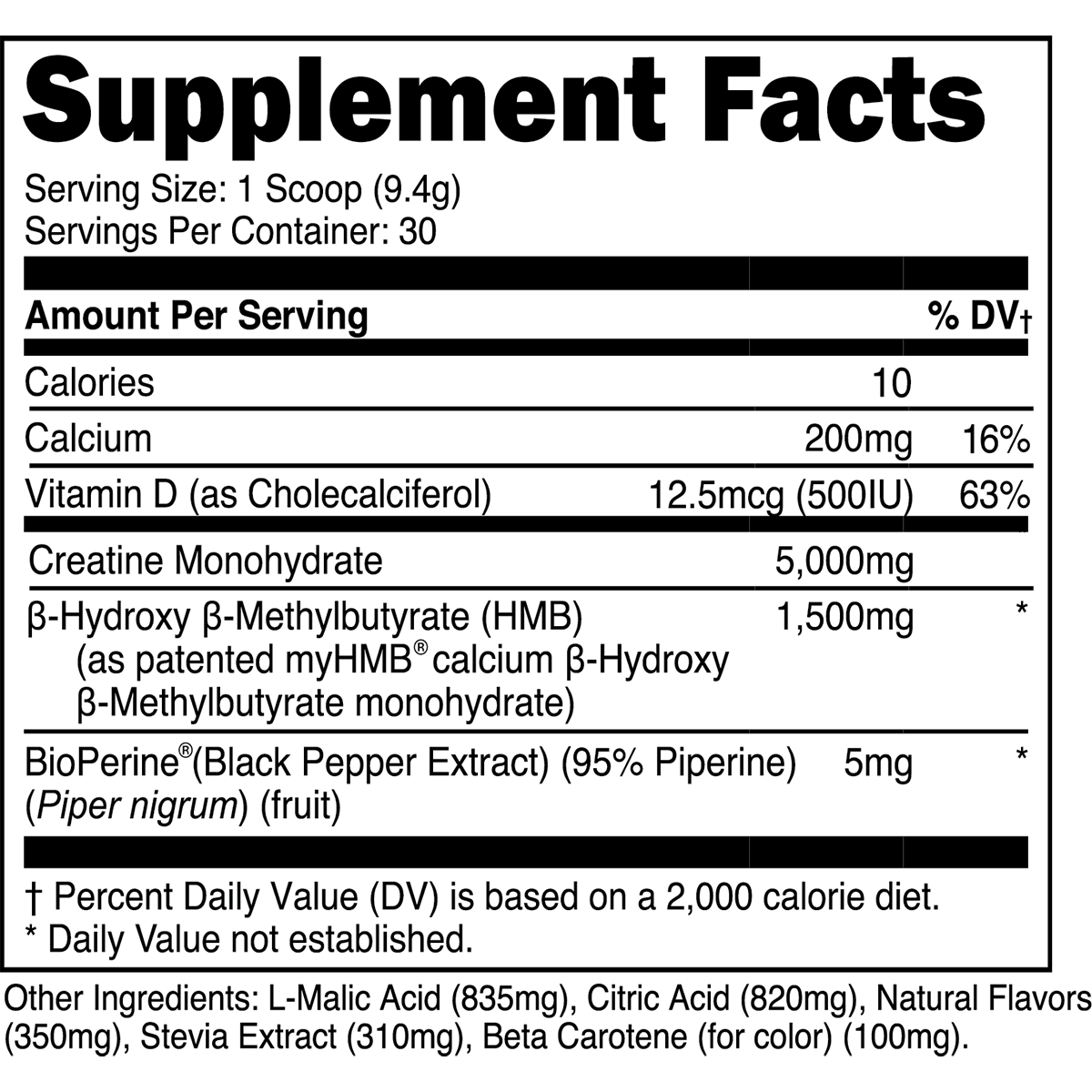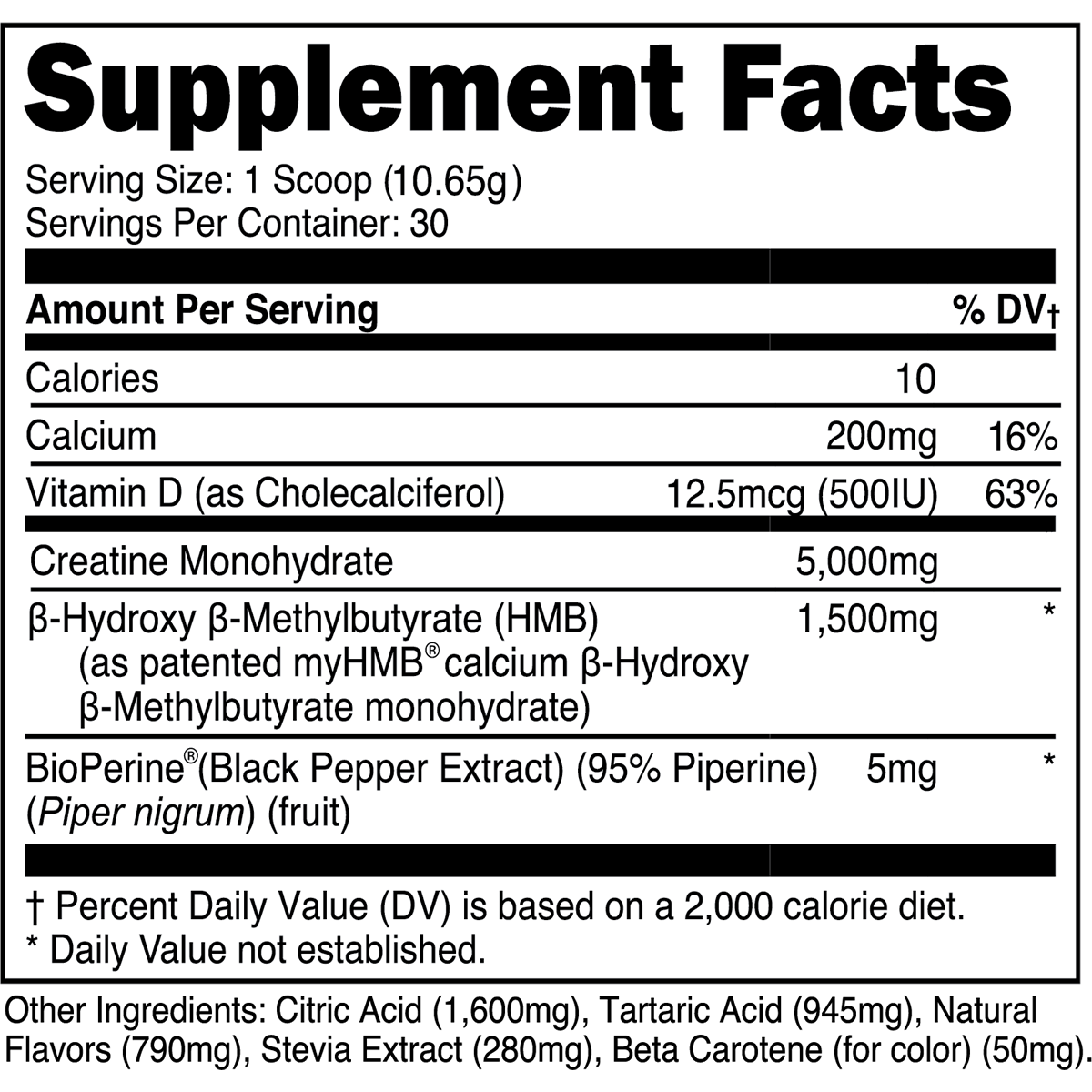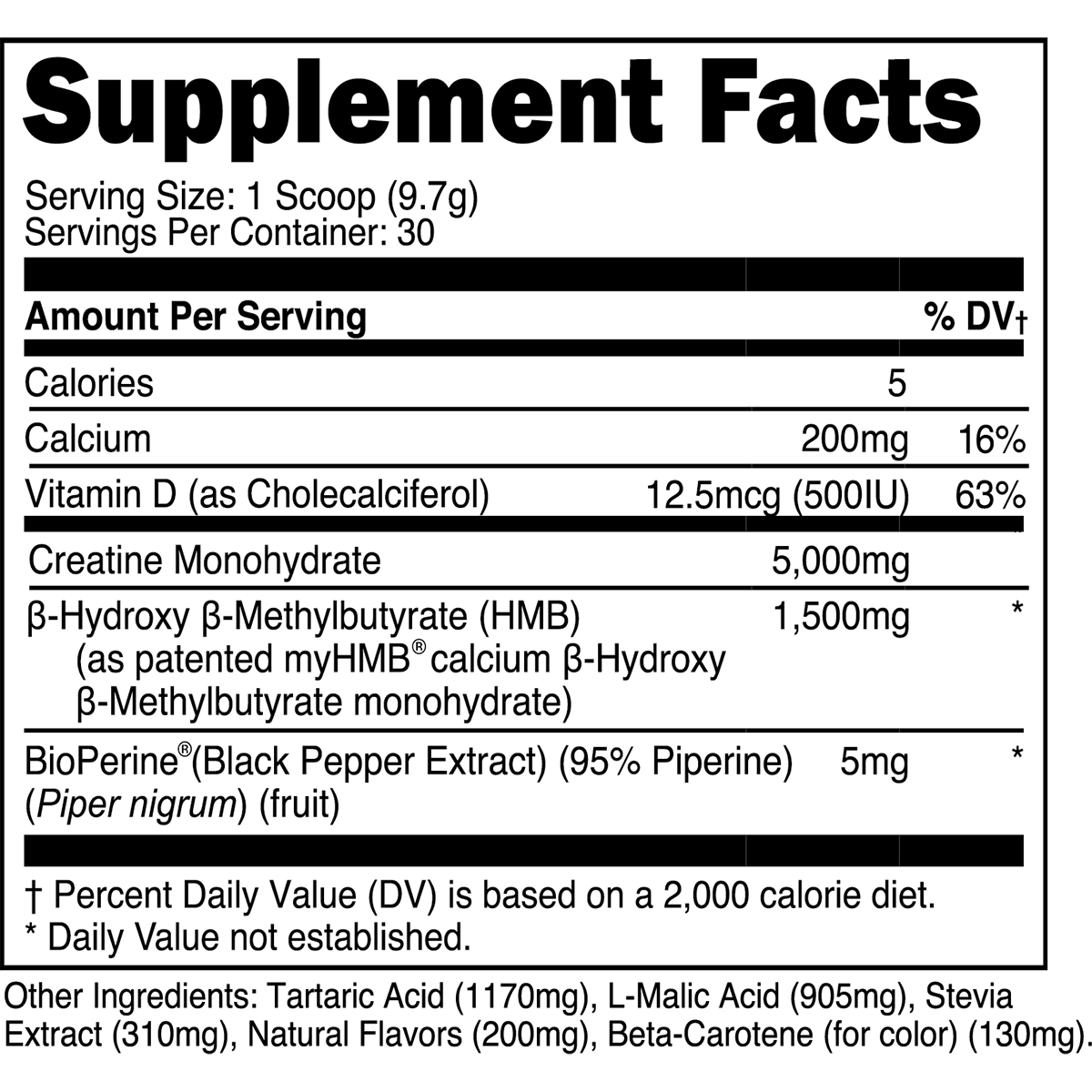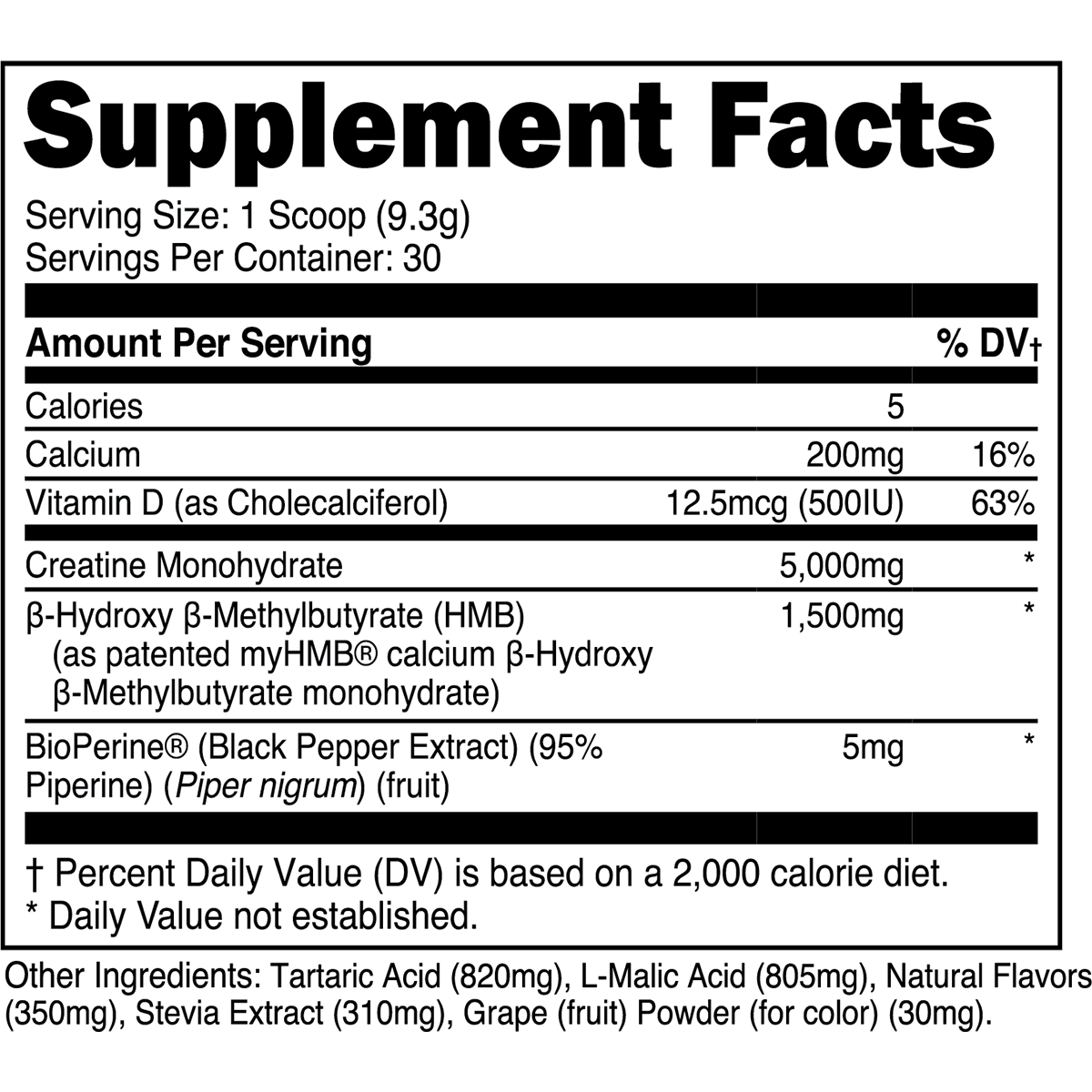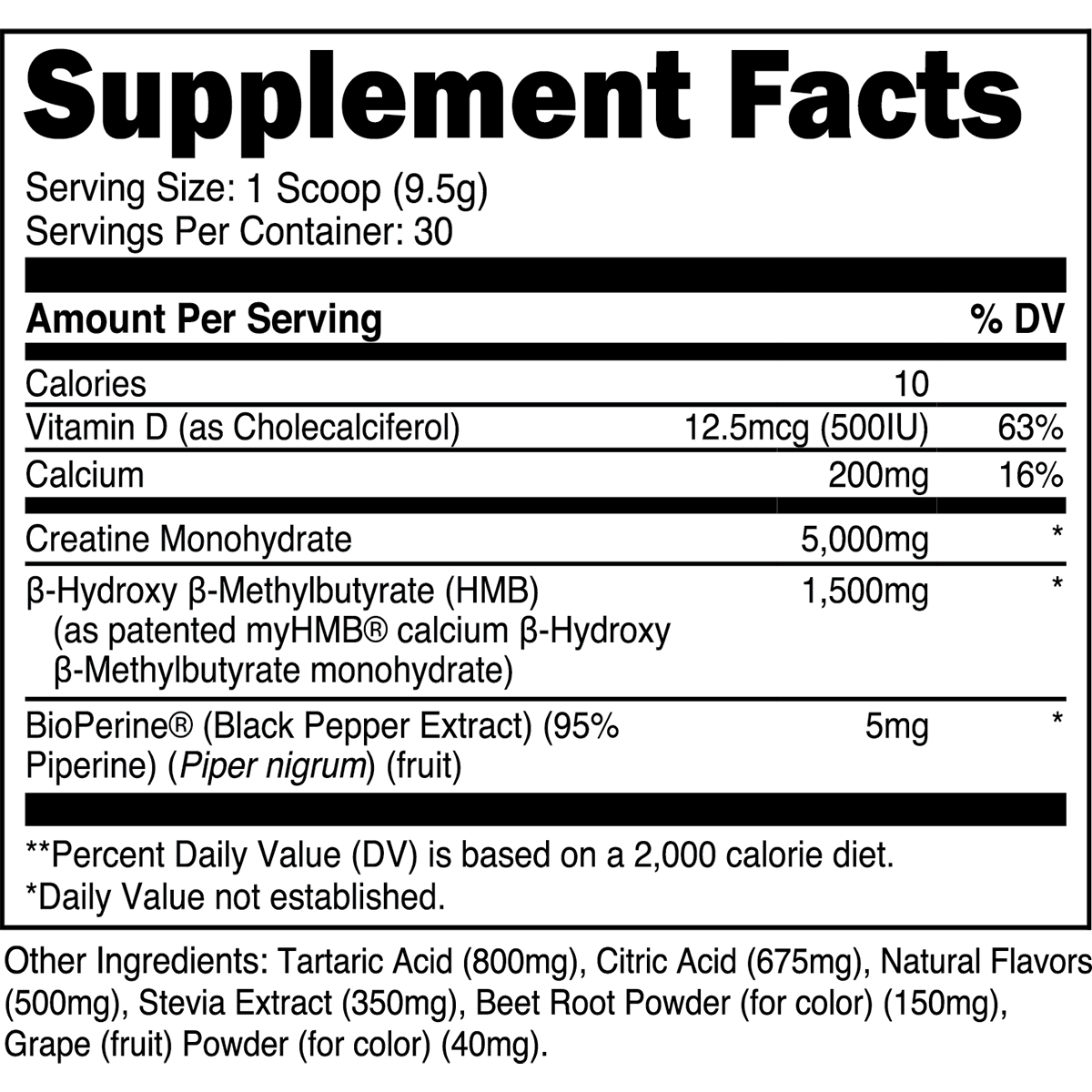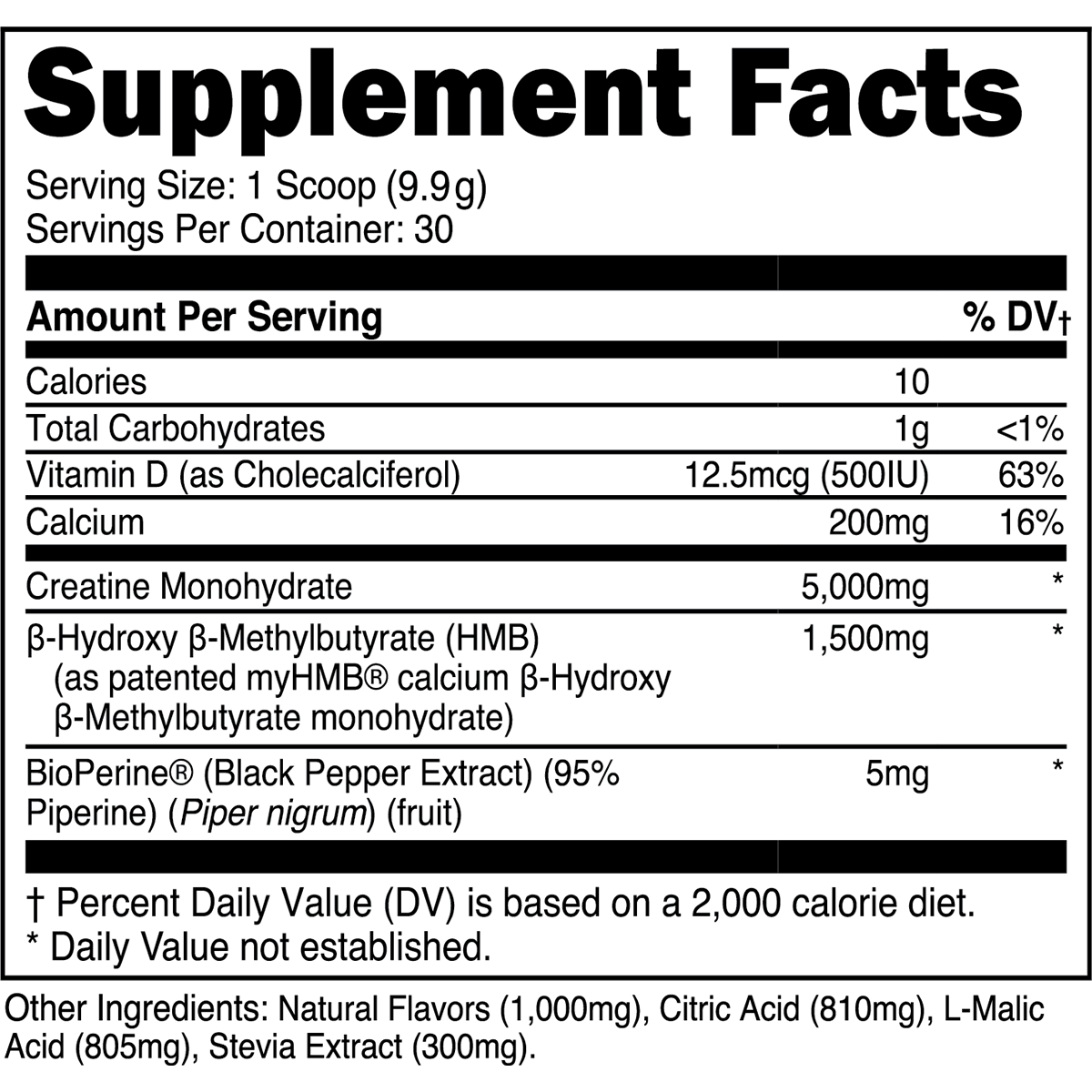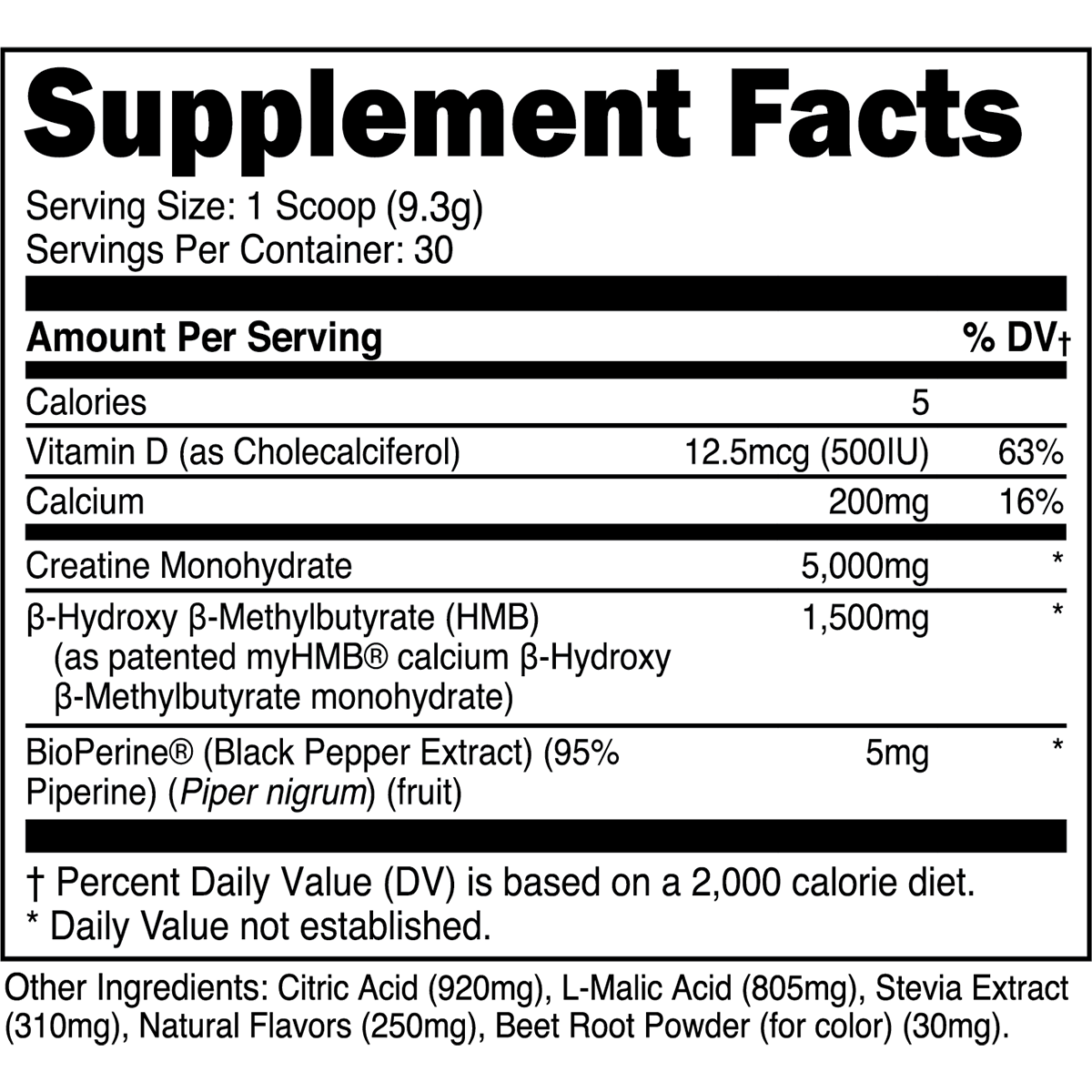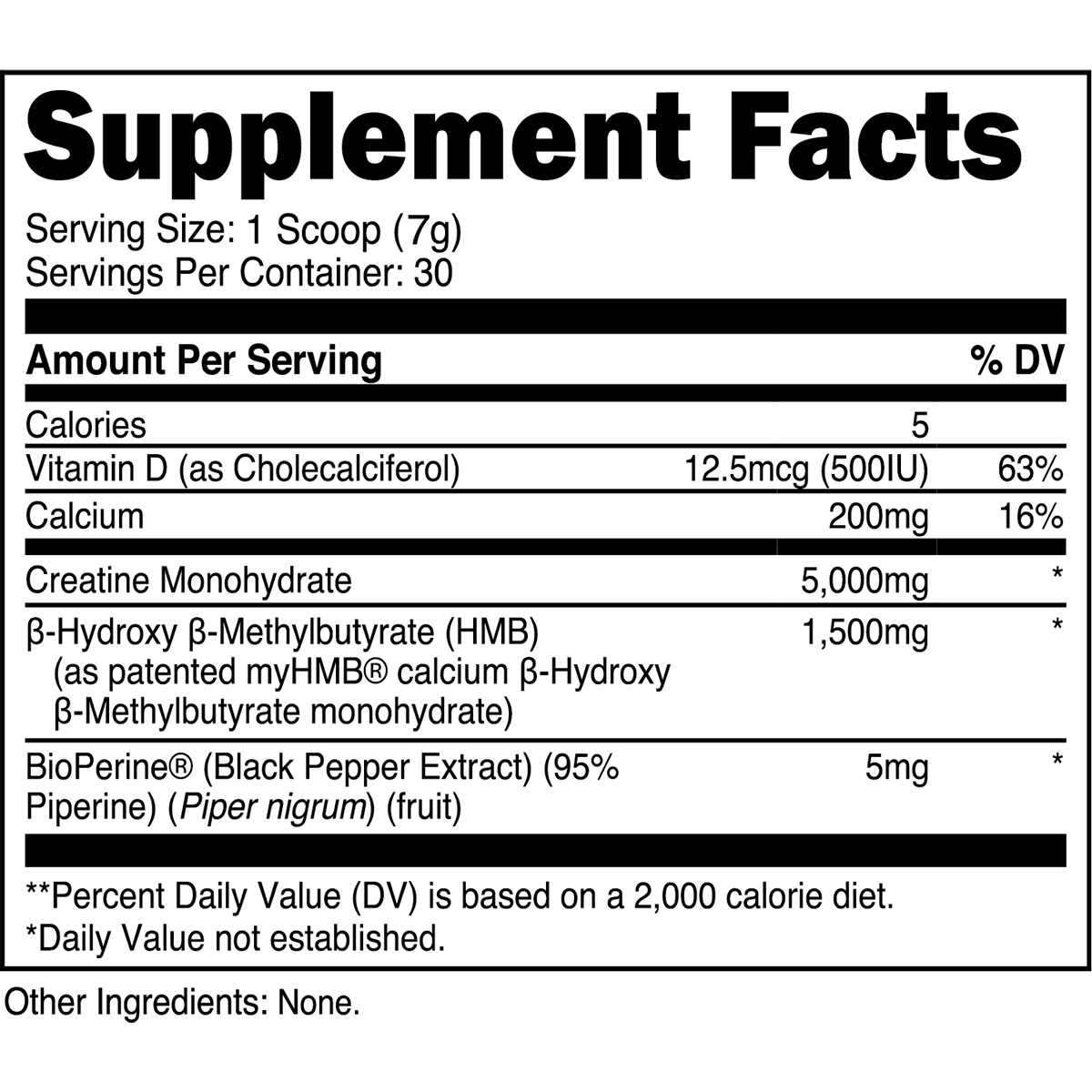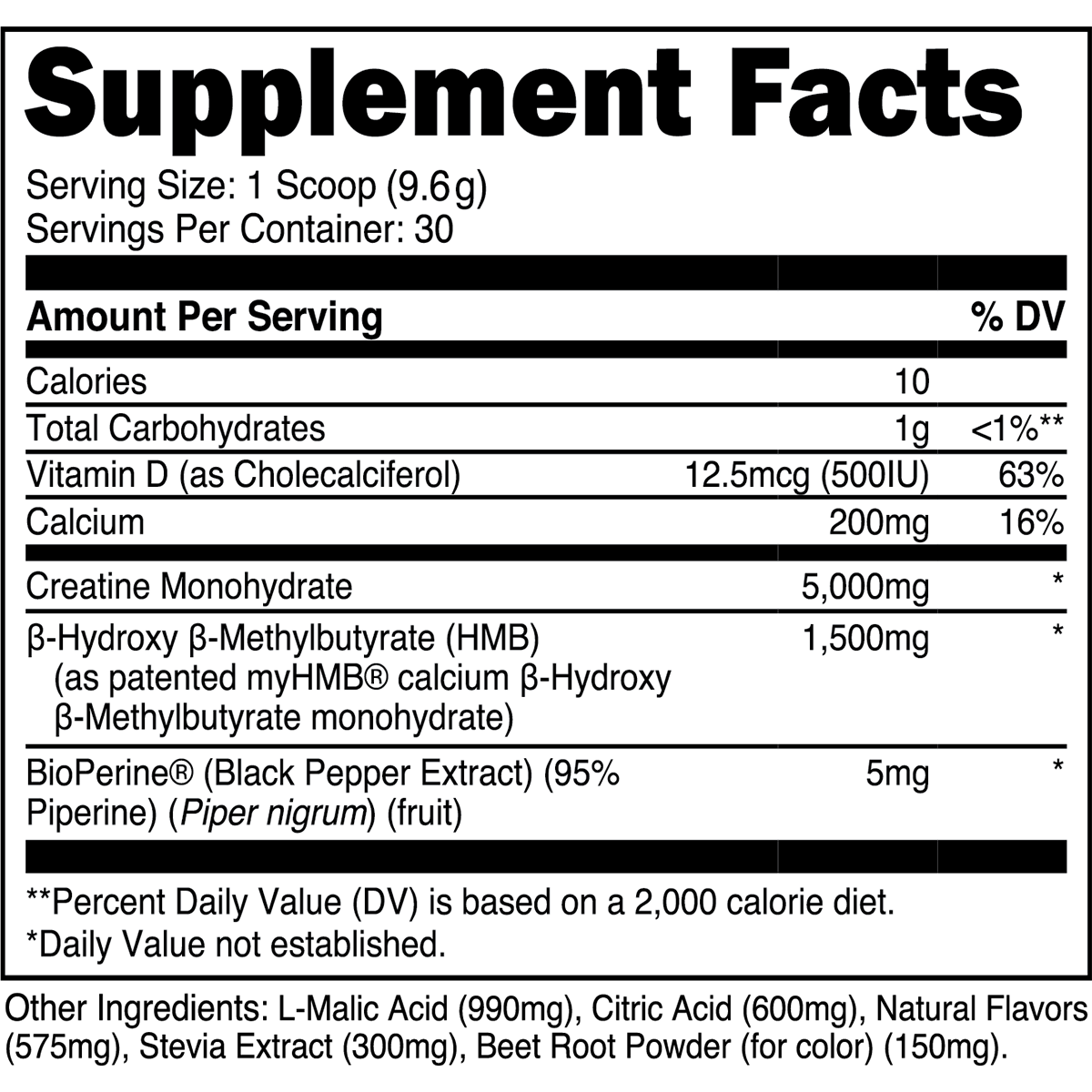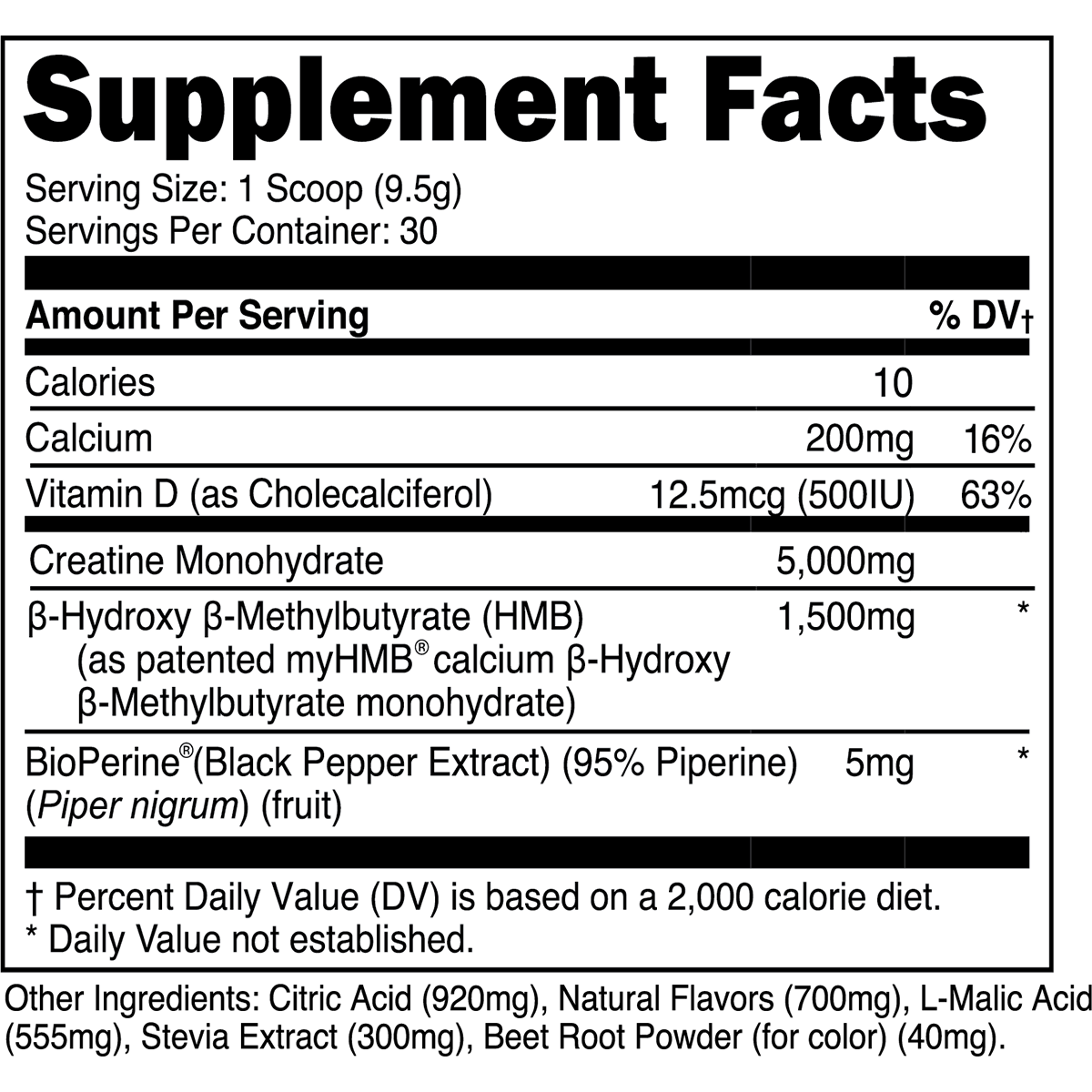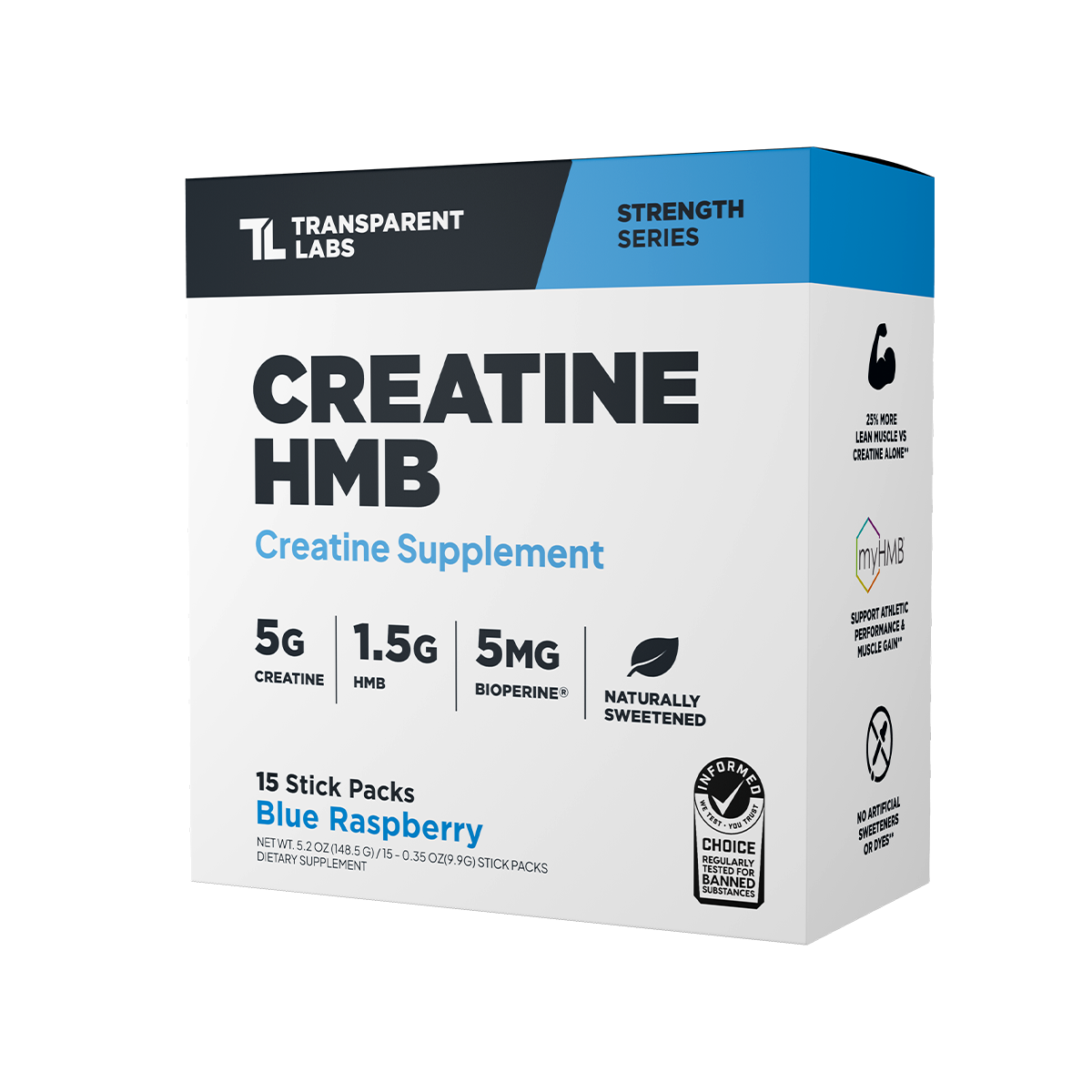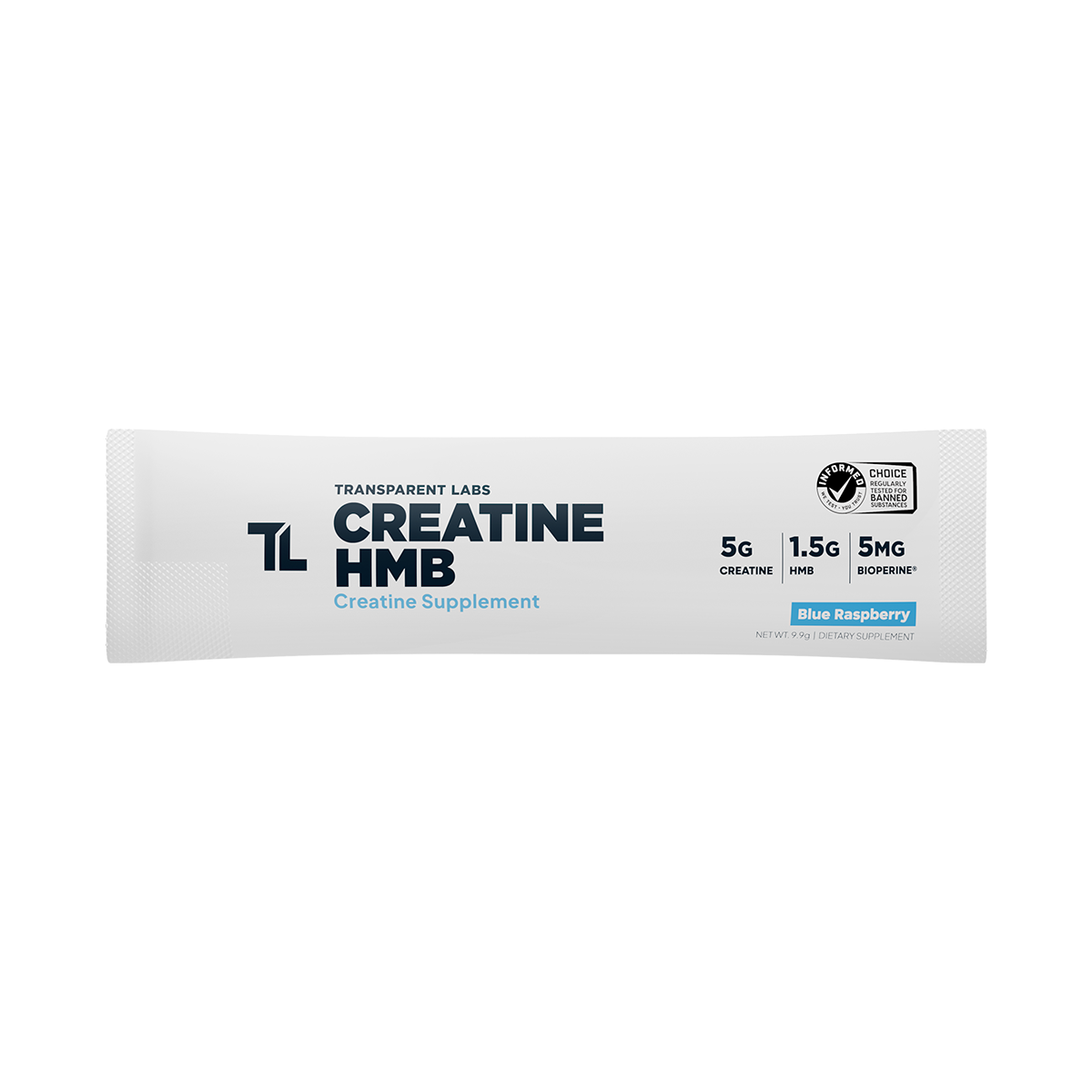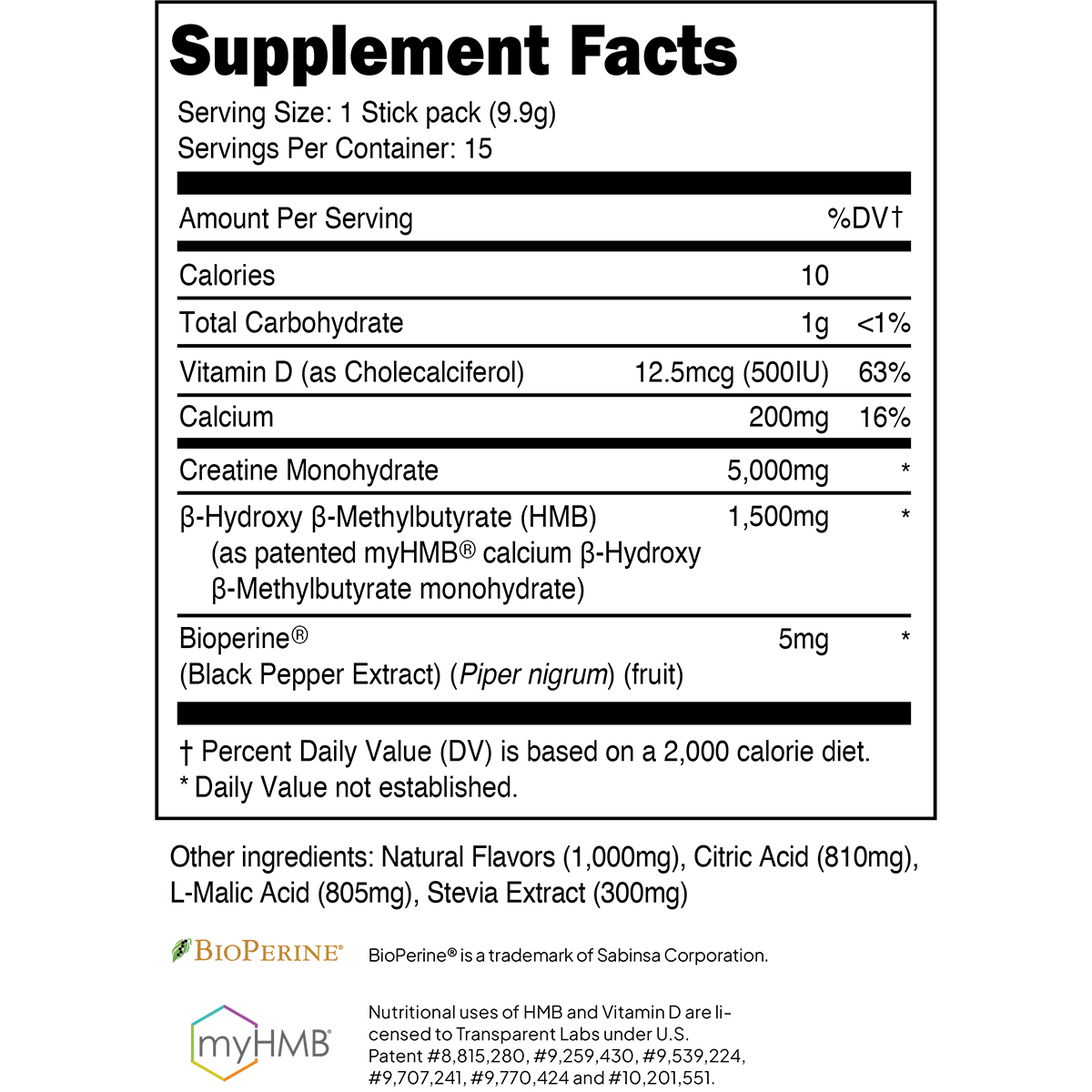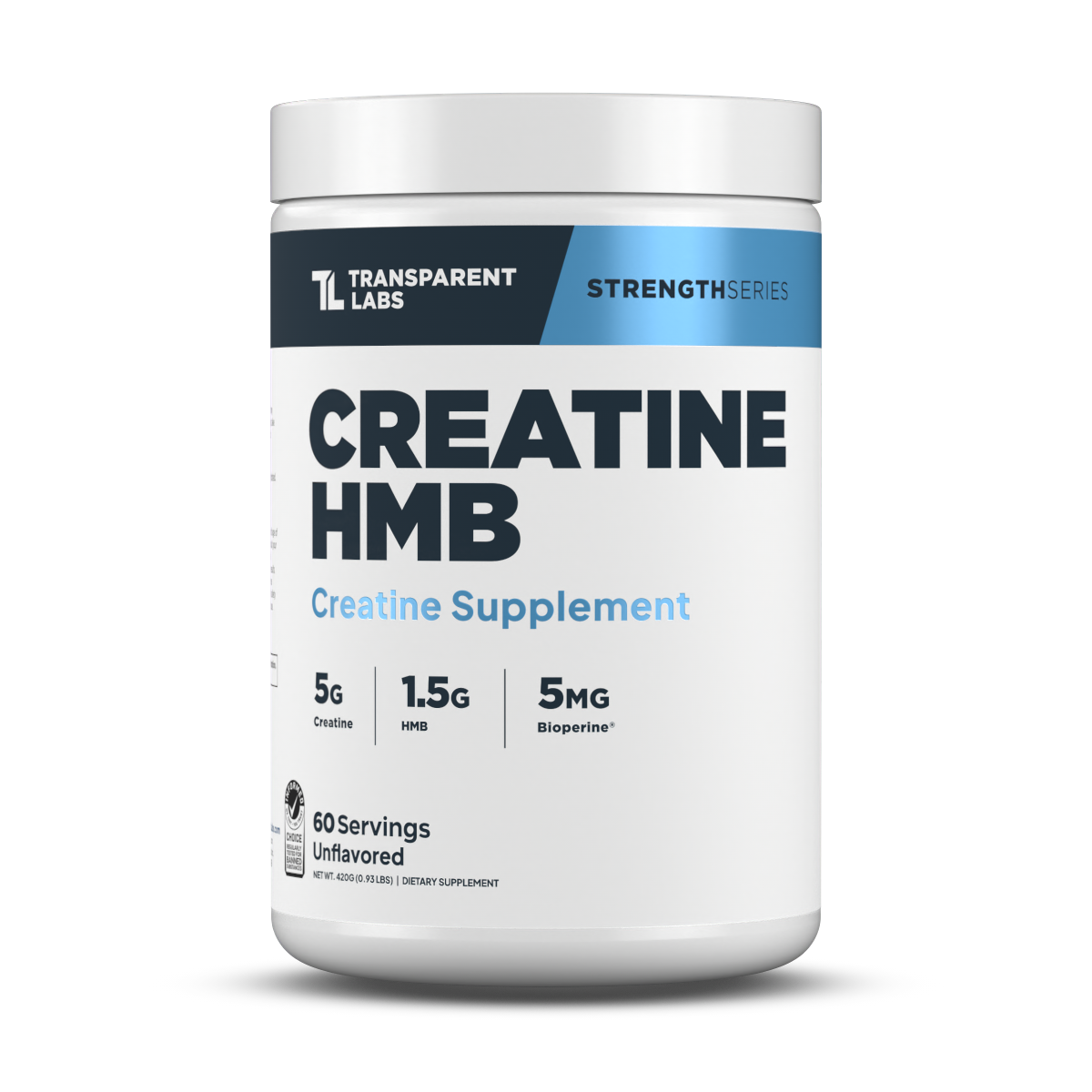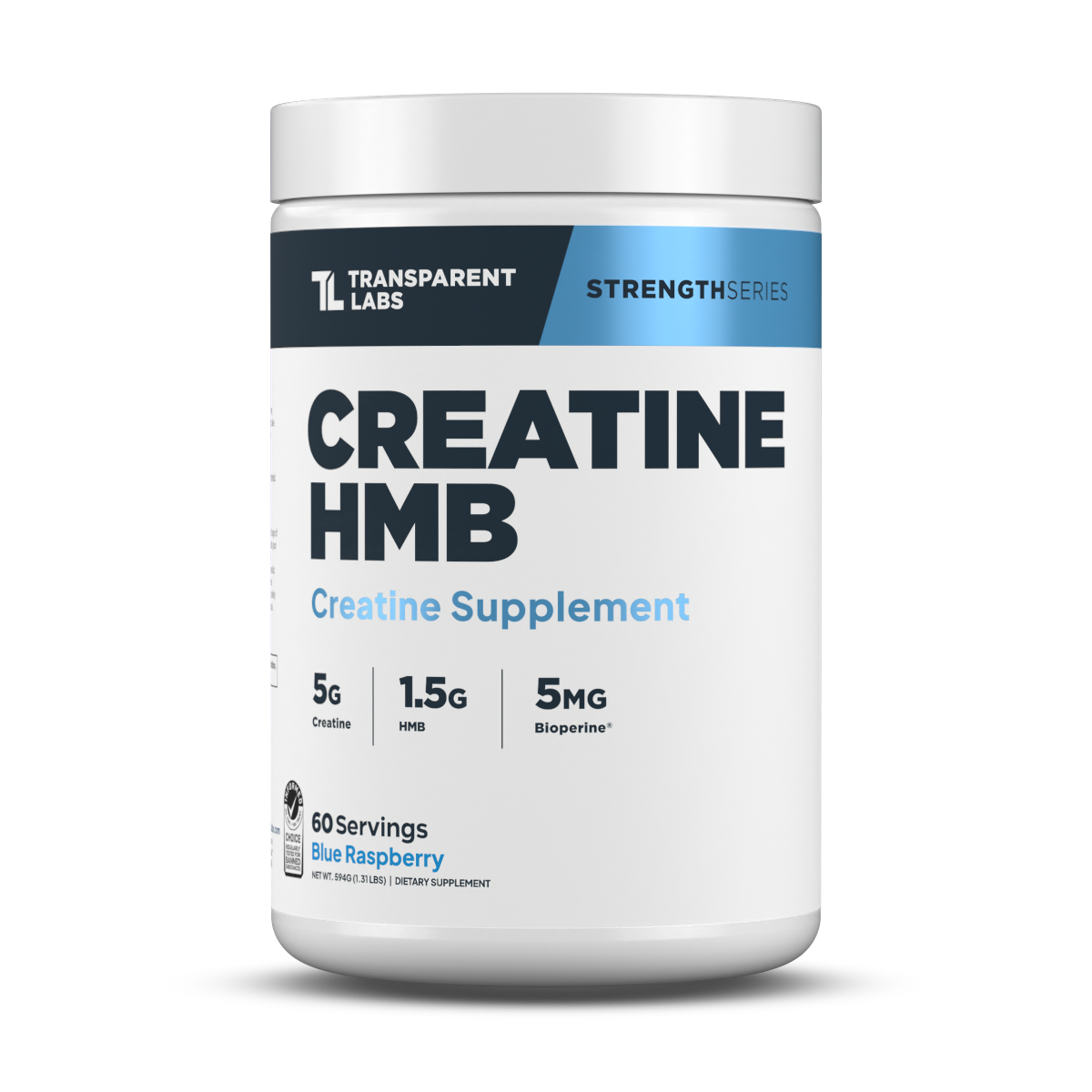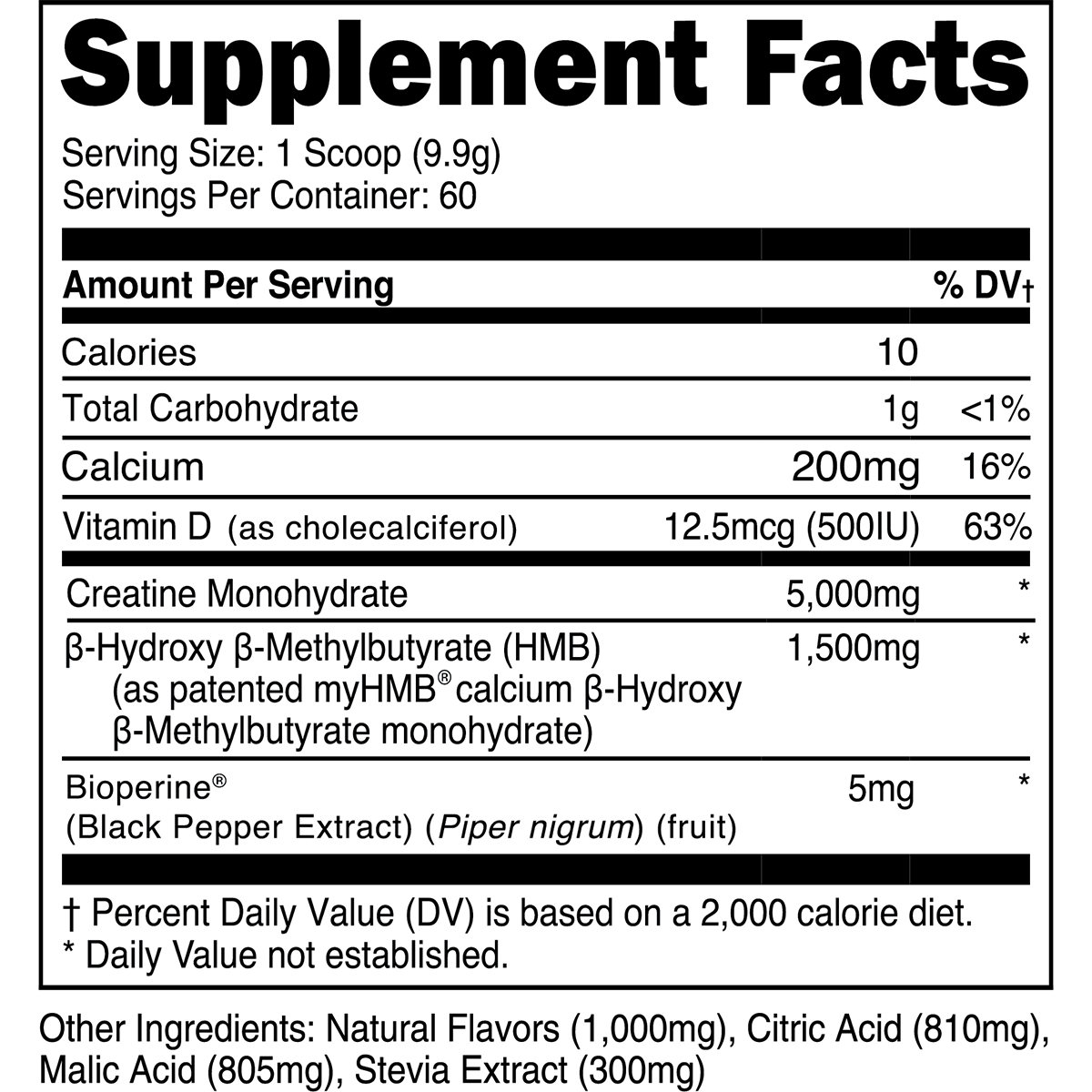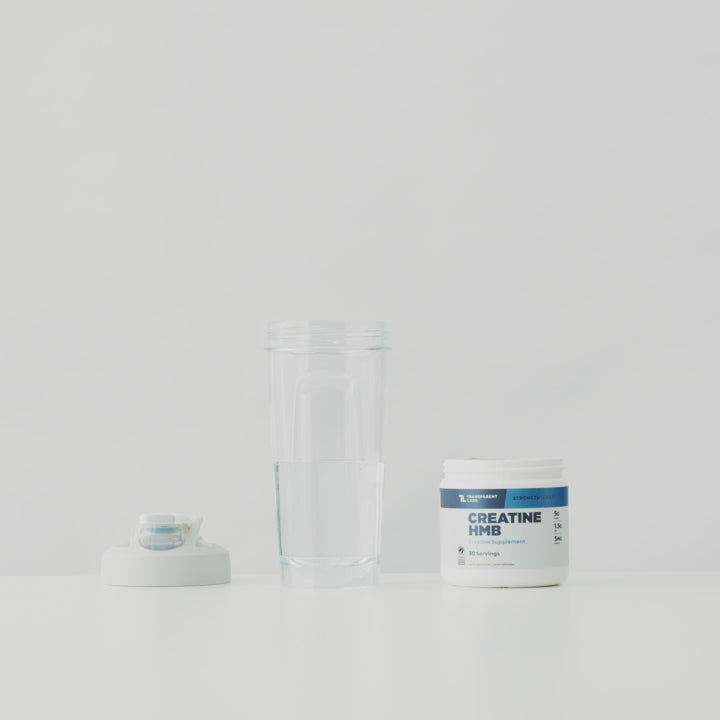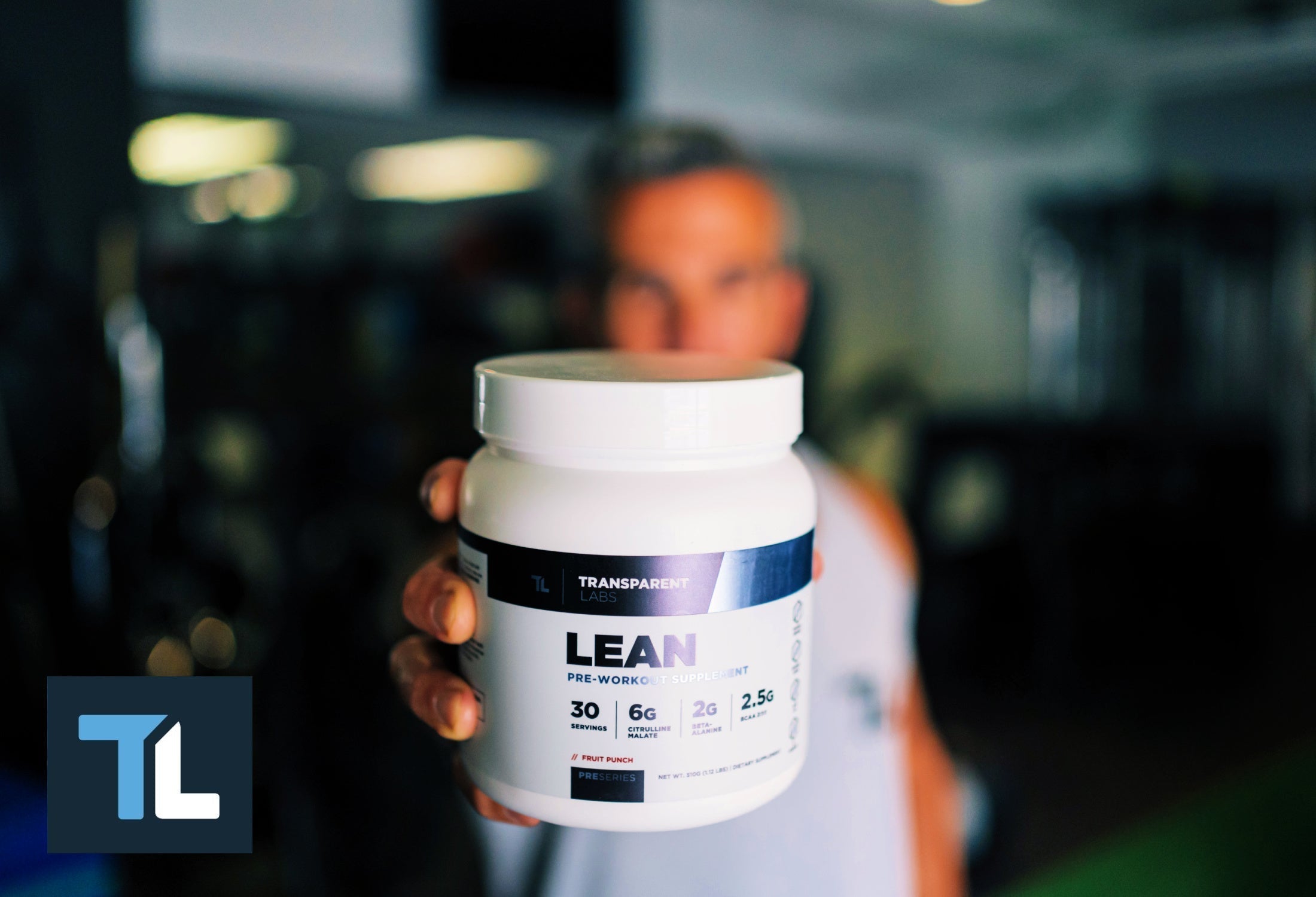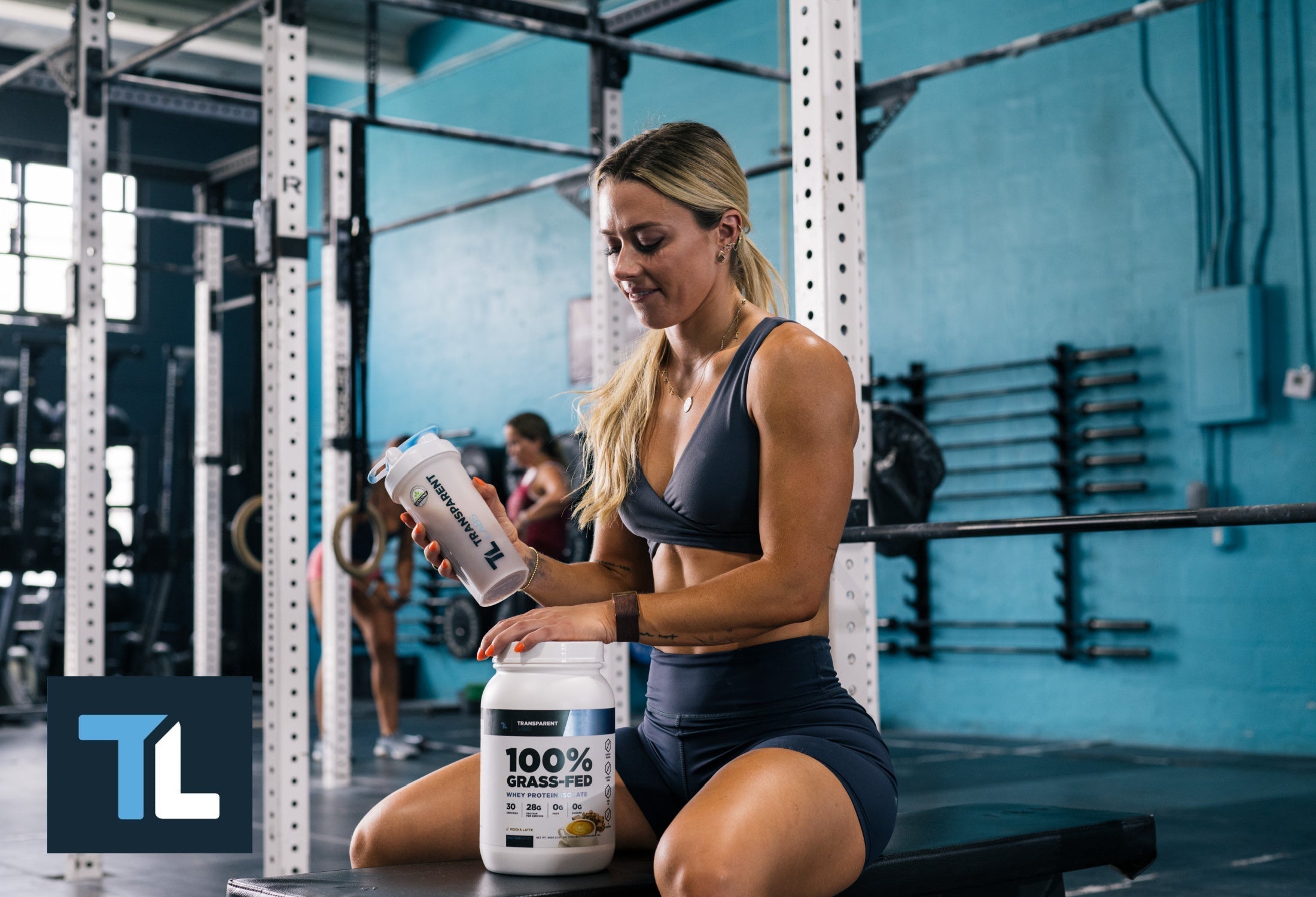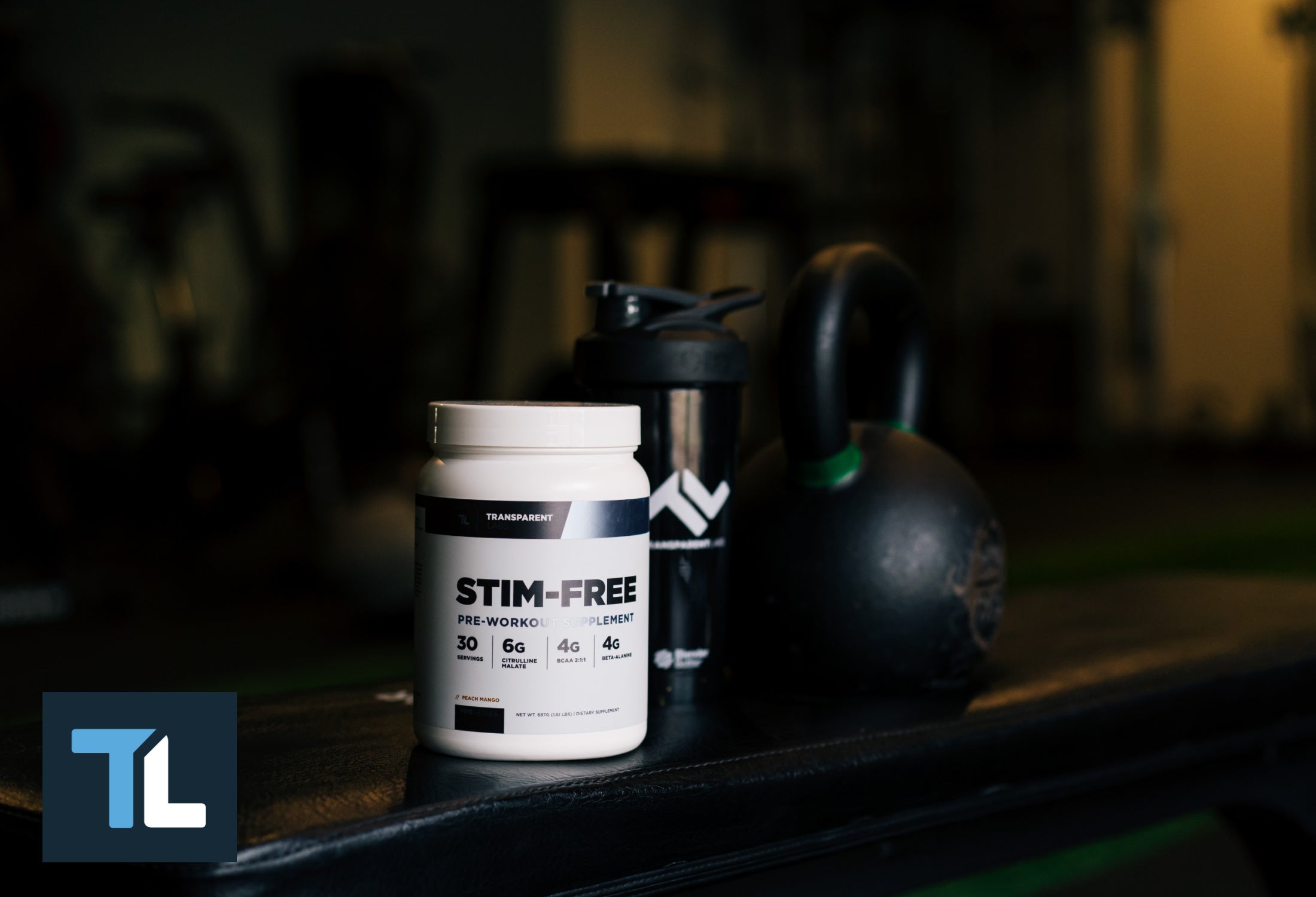Whether you’re comparing options or already have Transparent Labs Creatine HMB in hand, consider this your informational hub and guide for integrating it into your daily nutrition plan. You’ll learn how each ingredient works in the body, why we’ve paired these ingredients together, how to dial in your routine, and what results you can expect to experience.
What is Transparent Labs Creatine HMB?
Unlike ordinary creatine supplements, Transparent Labs Creatine HMB combines creatine monohydrate and Beta-Hydroxy-Beta-Methylbutyrate—commonly simplified to HMB—to create a uniquely efficient strength and recovery supplement. Both creatine and HMB are compounds derived from amino acids, and each of them supports the creation and preservation of muscle tissue in a different way.
By combining these two beneficial compounds together within the same formula, Transparent Labs is providing you with a two-pronged approach to muscle support that helps you to grow and retain a greater quantity of muscle tissue than you would if you were consuming only one of these ingredients. This results in more rapid size and strength gains in the short term, and greater overall gains over time.

What is Creatine Monohydrate?
If you have any goals connected to improving your athletic performance, building lean muscle mass, or improving your body composition, you will undoubtedly benefit from some form of supplementation with creatine monohydrate — one of the most extensively studied and scientifically validated nutritional supplements in history according to the International Society of Sports Nutrition. (1)
The benefits of creatine monohydrate have been so conclusively proven that creatine supplementation is practically universal amongst the world’s most elite athletes. This is particularly true of those whose livelihood is in some way tied to the optimization of physical performance.
Creatine monohydrate is an isolated form of three amino acids — arginine, glycine, and methionine — that saturate your skeletal muscle. From this saturation of your skeletal muscle comes a whole host of benefits to your physical performance, the most immediate of which are improvements in athletic strength and muscle endurance caused by creatine easing the transitions between your body’s energy system, and its rapid regeneration of adenosine triphosphate, or ATP.
How Does Creatine Work?
After being stored within your body’s skeletal muscle as phosphocreatine, creatine’s presence factors into several processes related to physical performance.
During times of increased energy consumption and muscle contraction, creatine is converted into adenosine triphosphate, or ATP. In that form, it serves as an energy source, aiding muscle contraction during resistance training, and easing energy production processes during anaerobic performance or sports performance.
Following resistance training, creatine is also released into the blood in the form of the enzyme creatine kinase, which is a mark of muscle damage or tissue damage. Creatine kinase levels decrease naturally as muscle cells repair themselves, which usually takes up to 36 hours after intense exercise.
By continuously supplementing with creatine monohydrate, your skeletal muscle stays “saturated,” which accelerates the rate at which muscle damage is repaired, and rapidly decreases the level of creatine kinase present in your blood.

What is Beta-Hydroxy-Beta-Methylbutyrate (HMB)?
As we’ve already established, the “HMB” you see written on the side of the Transparent Labs Creatine HMB container stands for Beta-Hydroxy-Beta-Methylbutyrate, which is a metabolite of the amino acid leucine. Provided that your food contains ample amounts of leucine, your body is able to produce baseline levels of Beta-Hydroxy-Beta-Methylbutyrate from your food that are sufficient to fulfill your most basic needs.
However, in order to achieve the well-established benefits linked to HMB, dedicated HMB supplementation with this metabolite is required. This is similar to the case with creatine monohydrate, which is practically impossible to be safely consumed through food alone at the levels required to achieve results.
Taken on its own, HMB is offered as a supplement to stimulate muscle protein synthesis, prevent muscle breakdown, and reduce the muscle damage associated with both physical strain and tissue-hindering illnesses.
How Does HMB Work?
HMB acts upon your muscles by limiting the activity of the ubiquitin-proteasome system, which is responsible for muscle breakdown. In addition to this, HMB also promotes muscle protein synthesis by stimulating the mammalian target of rapamycin, which regulates the growth of cells, including muscle cells.
As opposed to promoting cellular activity by causing ATP levels to surge in a manner akin to creatine, HMB triggers the release of insulin-like growth-factor 1, also simply known as growth hormone. This gentle nudge to your body’s natural hormone levels helps you increase muscle mass on the back end of resistance training.
Through these two methods of attack, HMB prevents the loss of hard-earned muscle tissue during your downtime while simultaneously empowering you to build even more muscle mass on top of it.
Why Take Creatine with HMB Over Creatine Alone?
These two superheroes of sports nutrition work through complementary mechanisms to deliver additive results for strength, performance, and lean muscle gains. (2)
Creatine helps your muscles recycle ATP faster so you can grind out extra reps and push higher peak power. HMB helps your muscles hold onto more of that hard-earned work by reducing muscle protein breakdown, supporting membrane repair, and signaling for rebuilding. Put them together and you get more training stimulus and better recovery—and according to science— greater lean-mass and performance gains than creatine alone.
In a gold-standard clinical trial (double-blinded, randomized, and placebo controlled), researchers found that the combination of creatine and HMB added 67 percent more lean muscle mass compared to creatine alone. In addition, participants experienced a 33 percent greater increase in total weight lifted compared to creatine alone. (3)
All to say, by engaging in combined supplementation with creatine monohydrate and HMB, you should expect to accelerate your performance during exercise, accumulate more muscle mass, and recover faster from exercise-induced muscle damage.

Benefits of Using Creatine
There are numerous benefits associated with creatine monohydrate supplementation, and they are well documented. Quite frankly, it’s amazing that the field of sports nutrition has unearthed what amounts to a strength-and-conditioning “hack” that stems from saturating your skeletal muscle with a compound composed of three simple amino acids.
No matter how many supplements have come and gone, creatine monohydrate remains the king of the sports nutrition world due to how many ways it can grant your body a physical advantage.
Below are some of the most notable benefits of creatine monohydrate supplementation.
Do More Quality Work Per Set
Creatine elevates intramuscular phosphocreatine, speeding ATP resynthesis so you sustain high-intensity efforts. A meta-analysis (collection of randomized controlled trials and studies) found a significant increase in average power during repeated sprint tests. (4)
Add Lean Mass When You Train
Across 35 randomized controlled trials, creatine increased lean body mass by approximately 2.2 pounds overall, and the effect was even greater when combined with resistance training. Imaging-based work also shows a small but significant hypertrophy (increase in muscle size) benefit. (5)
Build More Strength From the Same Training
Data indicates creatine enhances upper- and lower-body strength in adults engaged in resistance training. (6) This is one of the core ergogenic benefits of creatine alone—and complements HMB’s anti-catabolic/recovery emphasis.
Recover Glycogen Stores Faster
Creatine can augment post-exercise glycogen supercompensation within 24 hours following exercise and has been shown to increase glycogen storage useful for team sports or long athletic events. (7)
Hold Hard Efforts and Finish Faster.
Creatine can nudge up your lactate (ventilatory) threshold—your body’s “redline” where the burn kicks in—so you can sustain higher efforts before fatiguing. It also helps you repeat hard bursts (surges, hills, finishing sprints) with less drop-off. (8) (9)

Benefits of Using Creatine with HMB
Consuming creatine and HMB together adds anti-catabolic/recovery complementarity from HMB and additional lean muscle and strength gains, thus providing complete benefits for performance, strength, body composition, and recovery.
See Results Faster (In as Little as 3 Weeks)
If you’re pursuing rapid results in the form of elevated strength and muscle mass, and all of the physical upgrades that arrive alongside them, study results indicate that you would be hard pressed to find a combination that can deliver those results to you more swiftly than creatine and HMB.
In a double-blind, three-week-long study, all groups that supplemented with either creatine or HMB added noticeable muscle mass. However, the creatine-HMB group gained nearly 3.5 pounds of lean muscle on average after 3 weeks—67% better than the muscle mass increases from creatine alone. (3)
Build More Strength from the Same Training
This same 3-week trial showed the combo of creatine and HMB increased total weight lifted by 114 lb (51.9 kg) over placebo, versus ~86 lb (39.1 kg) with creatine—meaning 33% more work accomplished than just creatine alone.
Keep More of What You Train
HMB helps you retain more of the muscle you stress in training by dialing down muscle protein breakdown and supporting the signals that rebuild it. That pairs perfectly with creatine’s “do more quality work” effect—so more of your session turns into progress.
HMB accomplishes this by reducing activity in the body’s main protein-degradation systems (like the ubiquitin–proteasome and autophagy–lysosome pathways), so less of your contractile tissue is lost post-session. (10)
Optimize Hormones for Muscle Growth
In a 10-week, double-blind study in elite rowers, the creatine + HMB group saw higher testosterone and a better testosterone-to-cortisol ratio than placebo, creatine, or HMB alone. (11)
As a result, the combination of HMB and creatine offers a boost to muscle-building testosterone while supporting a more favorable anabolic-to-catabolic balance during training.
Dosage and Usage Tips
Dose: Take 1 scoop of Transparent Labs Creatine HMB once daily, which delivers 5 g creatine monohydrate and 1.5 g HMB. That 5 g/day keeps muscle creatine fully saturated over time and supports the performance and training adaptations seen in trials. However, depending on your body mass/size you may need more. A common guideline is ~0.1 g creatine/kg/day. For a ~100 kg (220 lb) athlete, that’s approximately 10 g/day—i.e., 2 scoops.
Timing: Take it whenever you’ll remember—morning, pre-, or post- exercise. If you want to be extra tactical, some data suggests post-workout consumption may provide a slight edge, but the difference is modest. (12)
With or Without Food: Taking creatine with a meal, snack, or shake that includes carbs and/or protein can improve whole-body creatine retention. This is because insulin facilitates creatine transport into muscle via the sodium-dependent creatine transporter (known as CreaT1).
Hydration & GI Comfort: Stay well-hydrated. Large single boluses of creatine can cause mild GI upset in some individuals. Staying hydrated can help ease these symptoms and support comfortable use. Creatine monohydrate is otherwise well-tolerated. If you have a sensitive GI system, consider half a scoop of Transparent Labs Creatine HMB twice daily.
Is a Loading Phase Necessary?
For decades, it has been a standard guidance that you should engage in a loading phase when first supplementing with creatine to quickly saturate your phosphocreatine stores for earlier onset benefits. Evidence now supports the premise that creatine loading is not an absolute requirement, but you may still wish to partake in a loading phase if you want to err on the side of caution.
The traditional creatine loading phase requires you to take 20 to 25 grams of creatine for a period of five to seven days. From there, creatine intake is reduced to maintenance doses of three to five grams to maintain muscle saturation.
Note that undergoing a full loading phase with Transparent Labs Creatine HMB would raise your daily HMB intake to 6g (assuming a 20g daily creatine loading phase). Short-term studies with HMB intake levels up to ~6 g/day report no adverse effects on standard clinical trials. However, 3g of HMB is the dose used in most efficacy and safety studies and endorsed by the ISSN. (13)

Potential Side Effects and Other Considerations
Most people experience few side effects from supplementing with creatine monohydrate, if any. The most common side effects stem from creatine’s tendency to draw water into your muscle cells, which occasionally results in cramping, bloating, and diarrhea.
HMB side effects are also rare, and generally fall into the territory of digestion-related issues like stomach discomfort and constipation. Therefore, combining HMB with creatine monohydrate may prove to be particularly uncomfortable to people who have a sensitivity to both, or for people who have temperamental digestive systems.
For what it’s worth, even if you experience these symptoms, you may want to continue your supplementation regimen for a few days, as these side effects will often subside with time, and especially after a loading phase is discontinued and is replaced by a maintenance phase.
The Best Combinations with Creatine HMB
Creatine and Protein Powder Are A Match Made in Heaven
If you find yourself enjoying your creatine HMB supplement and wish to add another beneficial supplement to your shelf to hasten your muscle and strength gains even further, you might be interested in one of the many protein supplements provided by Transparent Labs.
All of Transparent Labs’ protein supplements are formulated with a safe, effective, and ethically sourced form of protein that will provide your body with the essential quantities of amino acids it needs to repair damaged muscle tissue and strengthen your body.
Within the world of exercise and fitness, protein and creatine is perhaps the most common supplement combination precisely because they have been proven to work so well together. By combining Transparent Labs Creatine HMB with Transparent Labs Grass-Fed Whey Protein Isolate, or one of our other protein supplements, you can expect to see improvements to your body composition and performance that you never believed might be possible.
Learn more about Creatine
- Debunking Creatine Myths
- Creatine Timing: How Long Until You See Results?
- What Happens When You Stop Taking Creatine Supplements?
Sources
-
Buford TW, Kreider RB, Stout JR, Greenwood M, Campbell B, Spano M, Ziegenfuss T, Lopez H, Landis J, Antonio J. International Society of Sports Nutrition position stand: creatine supplementation and exercise. J Int Soc Sports Nutr. 2007 Aug 30;4:6. doi: 10.1186/1550-2783-4-6. PMID: 17908288; PMCID: PMC2048496.
-
Fernández-Landa J, Calleja-González J, León-Guereño P, Caballero-García A, Córdova A, Mielgo-Ayuso J. Effect of the Combination of Creatine Monohydrate Plus HMB Supplementation on Sports Performance, Body Composition, Markers of Muscle Damage and Hormone Status: A Systematic Review. Nutrients. 2019 Oct 20;11(10):2528. doi: 10.3390/nu11102528. PMID: 31635165; PMCID: PMC6835217.
-
Jówko E, Ostaszewski P, Jank M, Sacharuk J, Zieniewicz A, Wilczak J, Nissen S. Creatine and beta-hydroxy-beta-methylbutyrate (HMB) additively increase lean body mass and muscle strength during a weight-training program. Nutrition. 2001 Jul-Aug;17(7-8):558-66. doi: 10.1016/s0899-9007(01)00540-8. PMID: 11448573.
-
Glaister M, Rhodes L. Short-Term Creatine Supplementation and Repeated Sprint Ability-A Systematic Review and Meta-Analysis. Int J Sport Nutr Exerc Metab. 2022 Aug 30;32(6):491-500. doi: 10.1123/ijsnem.2022-0072. PMID: 36041731.
-
Delpino FM, Figueiredo LM, Forbes SC, Candow DG, Santos HO. Influence of age, sex, and type of exercise on the efficacy of creatine supplementation on lean body mass: A systematic review and meta-analysis of randomized clinical trials. Nutrition. 2022 Nov-Dec;103-104:111791. doi: 10.1016/j.nut.2022.111791. Epub 2022 Jul 8. PMID: 35986981.
-
Wang Z, Qiu B, Li R, Han Y, Petersen C, Liu S, Zhang Y, Liu C, Candow DG, Del Coso J. Effects of Creatine Supplementation and Resistance Training on Muscle Strength Gains in Adults <50 Years of Age: A Systematic Review and Meta-Analysis. Nutrients. 2024 Oct 28;16(21):3665. doi: 10.3390/nu16213665. PMID: 39519498; PMCID: PMC11547435.
-
van Loon LJ, Murphy R, Oosterlaar AM, Cameron-Smith D, Hargreaves M, Wagenmakers AJ, Snow R. Creatine supplementation increases glycogen storage but not GLUT-4 expression in human skeletal muscle. Clin Sci (Lond). 2004 Jan;106(1):99-106. doi: 10.1042/CS20030116. PMID: 14507259.
-
Forbes SC, Candow DG, Neto JHF, Kennedy MD, Forbes JL, Machado M, Bustillo E, Gomez-Lopez J, Zapata A, Antonio J. Creatine supplementation and endurance performance: surges and sprints to win the race. J Int Soc Sports Nutr. 2023 Dec;20(1):2204071. doi: 10.1080/15502783.2023.2204071. PMID: 37096381; PMCID: PMC10132248.
-
Chwalbiñska-Moneta J. Effect of creatine supplementation on aerobic performance and anaerobic capacity in elite rowers in the course of endurance training. Int J Sport Nutr Exerc Metab. 2003 Jun;13(2):173-83. doi: 10.1123/ijsnem.13.2.173. PMID: 12945828.
-
Wilson GJ, Wilson JM, Manninen AH. Effects of beta-hydroxy-beta-methylbutyrate (HMB) on exercise performance and body composition across varying levels of age, sex, and training experience: A review. Nutr Metab (Lond). 2008 Jan 3;5:1. doi: 10.1186/1743-7075-5-1. PMID: 18173841; PMCID: PMC2245953.
-
Fernández-Landa J, Fernández-Lázaro D, Calleja-González J, Caballero-García A, Córdova A, León-Guereño P, Mielgo-Ayuso J. Long-Term Effect of Combination of Creatine Monohydrate Plus β-Hydroxy β-Methylbutyrate (HMB) on Exercise-Induced Muscle Damage and Anabolic/Catabolic Hormones in Elite Male Endurance Athletes. Biomolecules. 2020 Jan 15;10(1):140. doi: 10.3390/biom10010140. PMID: 31952174; PMCID: PMC7022312.
-
Antonio J, Ciccone V. The effects of pre versus post workout supplementation of creatine monohydrate on body composition and strength. J Int Soc Sports Nutr. 2013 Aug 6;10:36. doi: 10.1186/1550-2783-10-36. PMID: 23919405; PMCID: PMC3750511.
-
Rathmacher, J. A., Pitchford, L. M., Stout, J. R., Townsend, J. R., Jäger, R., Kreider, R. B., … Antonio, J. (2024). International society of sports nutrition position stand: β-hydroxy-β-methylbutyrate (HMB). Journal of the International Society of Sports Nutrition, 22(1). https://doi.org/10.1080/15502783.2024.2434734
